How to Grow Alstroemeria (Peruvian Lily)
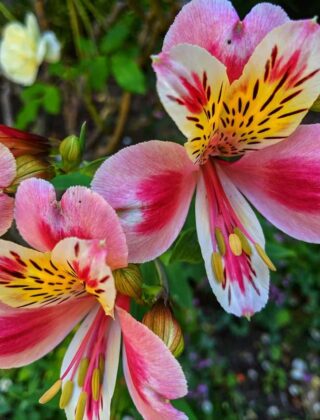
Introduction
Alstroemeria, commonly known as the Peruvian Lily or Lily of the Incas, is a captivating and vibrant flowering plant native to South America, particularly in Chile, Brazil, and Peru. Celebrated for its striking, multicolored blooms and delicate, trumpet-shaped petals, Alstroemeria brings exotic beauty to gardens and floral arrangements worldwide. These perennial plants, belonging to the Alstroemeriaceae family, thrive in various climates and are prized for their long-lasting flowers and lush foliage. The blooms typically showcase a dazzling array of colors, including pink, orange, red, purple, and white, often adorned with unique streaks and speckles that add to their ornamental appeal. Alstroemeria’s versatility, resilience, and stunning appearance make it a popular choice among gardeners, florists, and plant enthusiasts alike, symbolizing friendship, prosperity, and devotion. In this guide, we will walk you through everything you need to know to grow alstroemeria in your garden successfully.
Alstroemeria Varieties
Alstroemeria varieties are numerous, with breeders continually developing new hybrids to expand the range of colors, patterns, and plant characteristics. While it is challenging to list every single variety due to the vast number and ongoing development, here are some well-known and widely appreciated Alstroemeria varieties:
- Alstroemeria ‘Princess Louise’: Soft pink flowers with cream accents and darker pink streaks.
- Alstroemeria ‘Inca Ice’: Creamy apricot flowers with pink flushes and a yellow throat.
- Alstroemeria ‘Indian Summer’: Copper-orange blooms with yellow and red markings and dark foliage.
- Alstroemeria ‘Flaming Star’: Red and yellow flowers with dark streaks.
- Alstroemeria ‘Virginia’: Pure white flowers with subtle green streaks.
- Alstroemeria ‘Sweet Laura’: Fragrant, bright yellow flowers with orange accents.
- Alstroemeria ‘Apollo’: Soft pink blooms with deeper pink and white centers.
- Alstroemeria ‘Inticancha Bryce’: Bi-colored flowers with shades of purple and yellow.
- Alstroemeria ‘Rock & Roll’: Red flowers with white edges and intricate red streaks.
- Alstroemeria ‘Colorita Katiana’: Bold, red-orange flowers with a yellow center and dark streaks.
- Alstroemeria ‘Casablanca’: White flowers with lime-green markings.
- Alstroemeria ‘Butterscotch’: Yellow flowers with orange and red streaks.
- Alstroemeria ‘Selina’: Soft peach flowers with pink and yellow accents.
- Alstroemeria ‘Bonanza’: Bright orange flowers with yellow centers and red streaks.
- Alstroemeria ‘Third Harmonic’: Pale lavender flowers with darker purple streaks.
- Alstroemeria ‘Yellow Friendship’: Bright yellow flowers symbolize friendship.
- Alstroemeria ‘Tessa’: Dark pink blooms with a touch of yellow and red streaks.
- Alstroemeria ‘Lutea’: Pure yellow flowers.
- Alstroemeria ‘Orange Glory’: Bright orange flowers with darker markings.
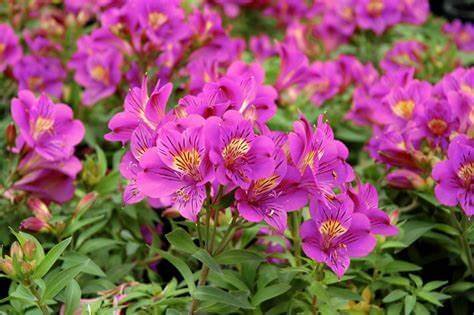
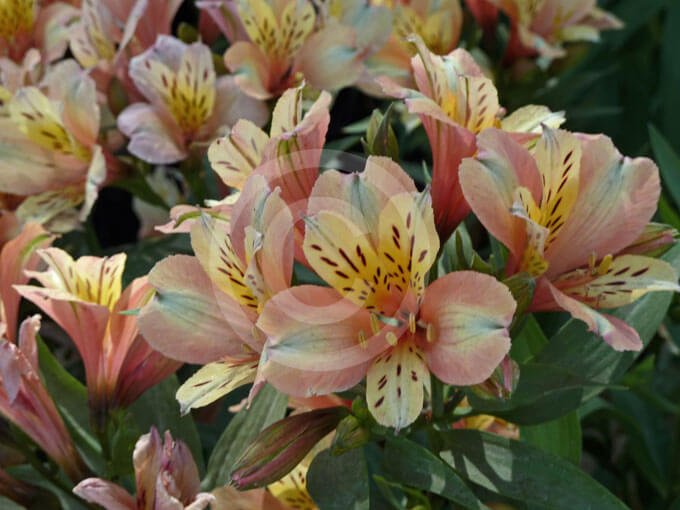
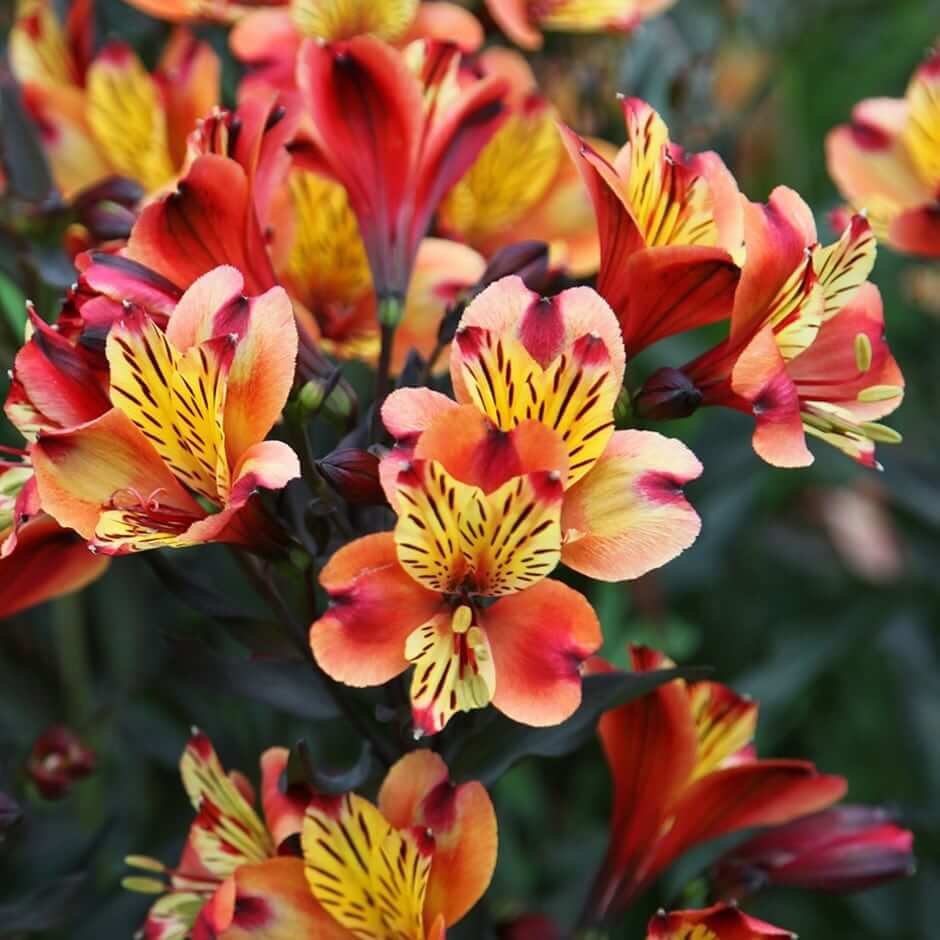
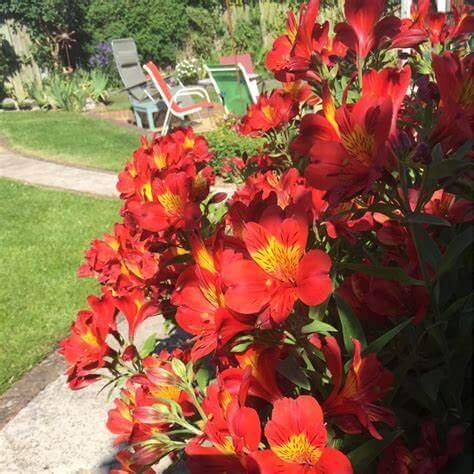
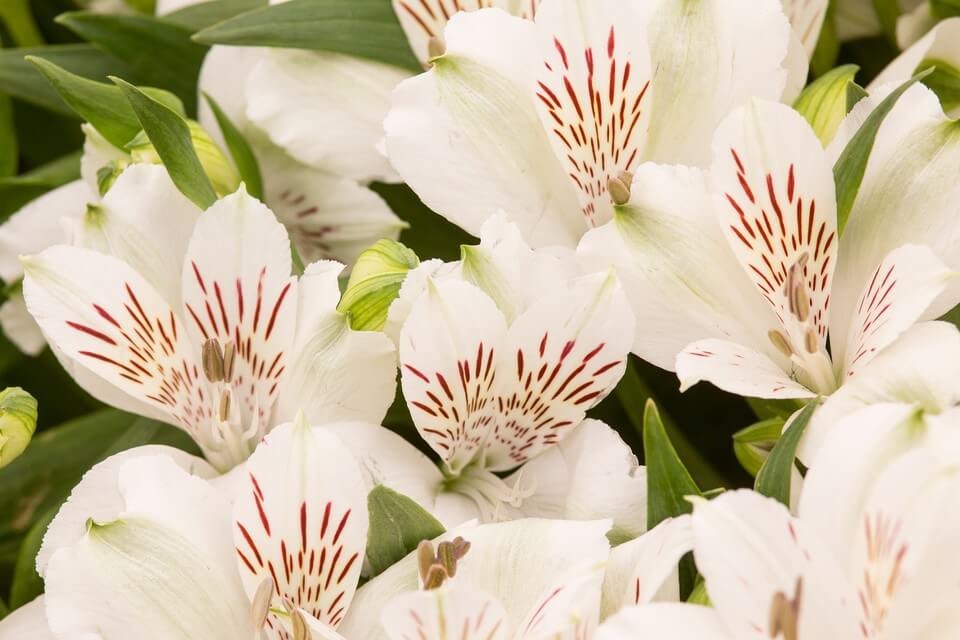
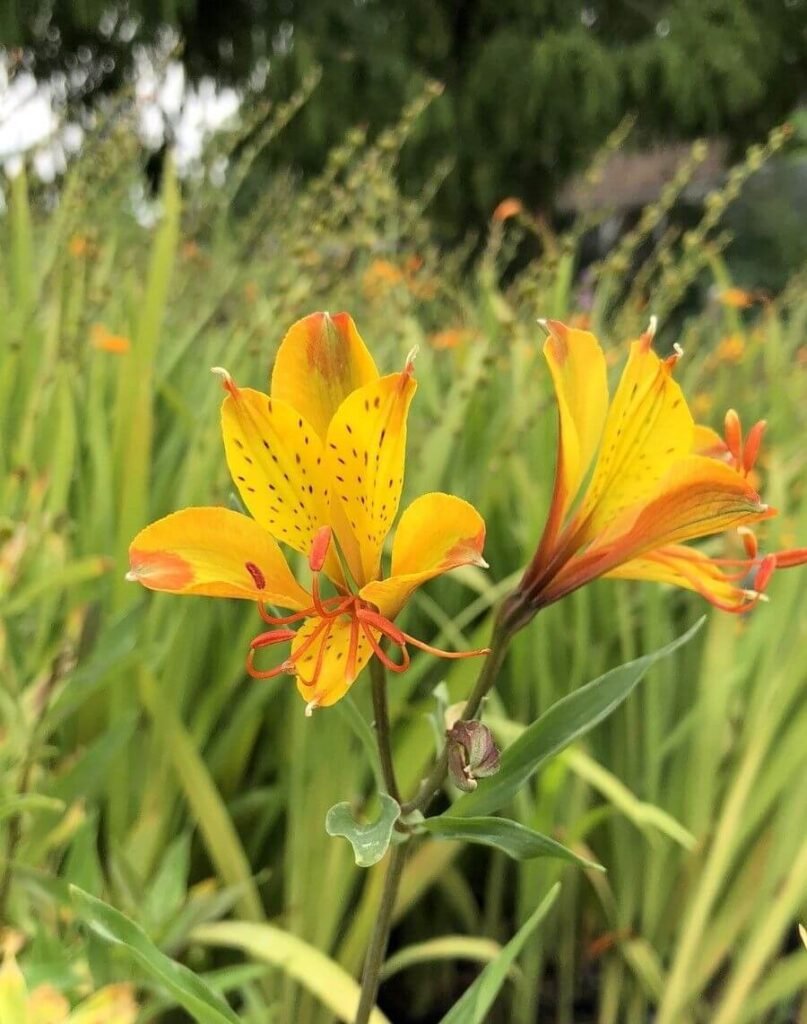
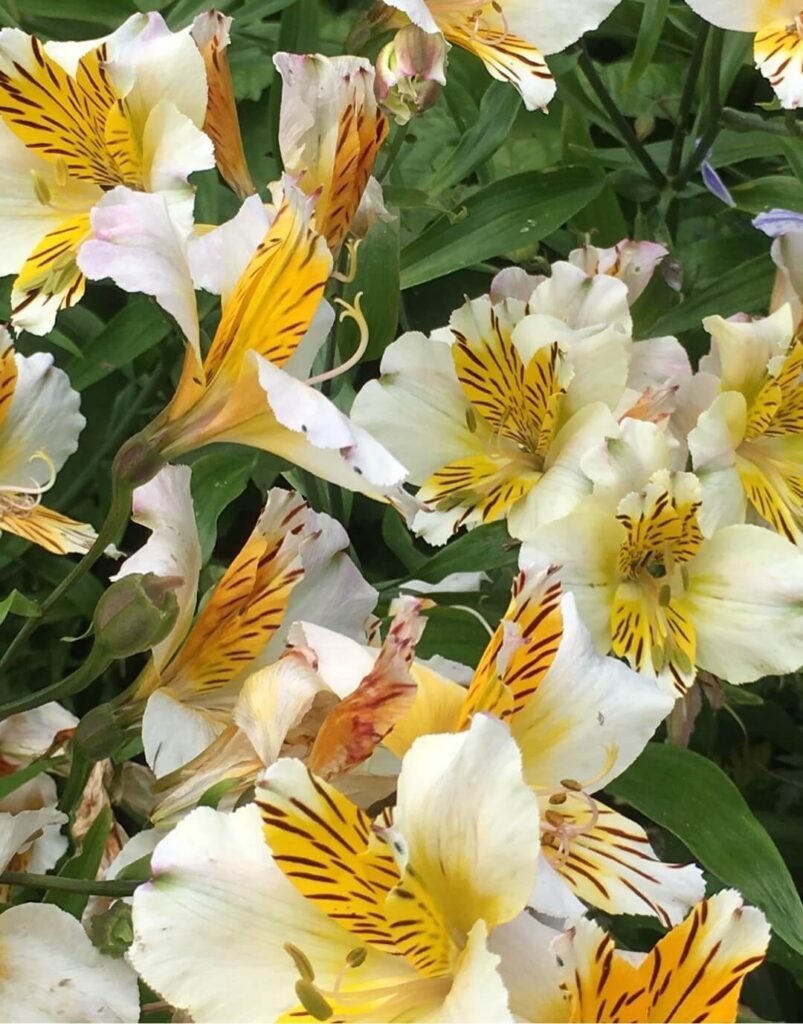
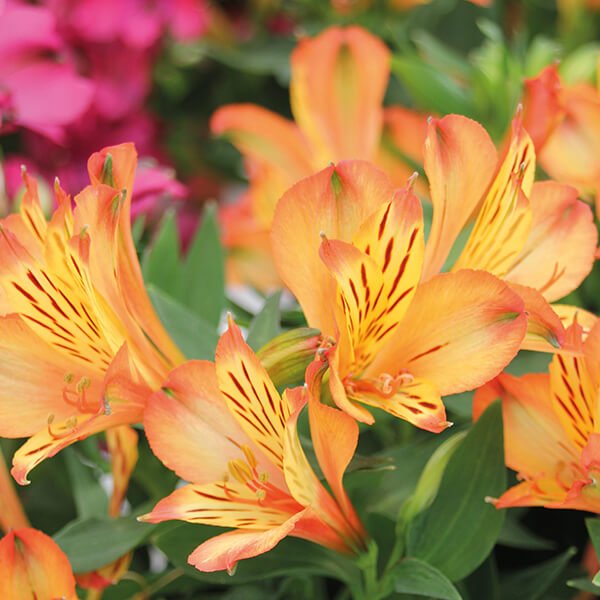
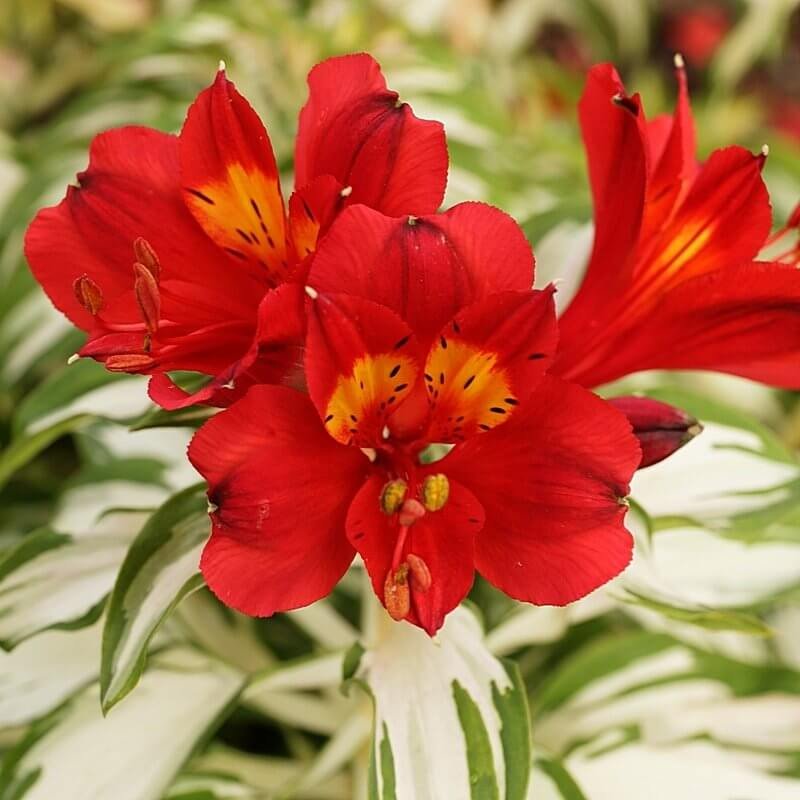
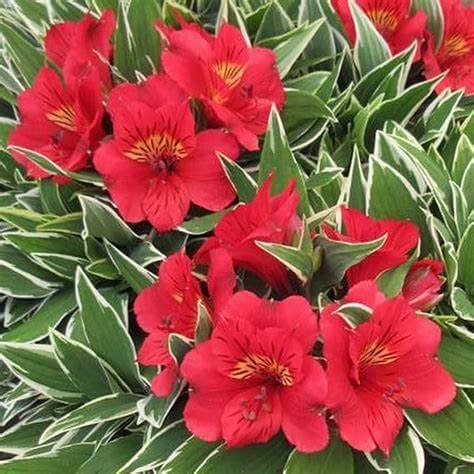
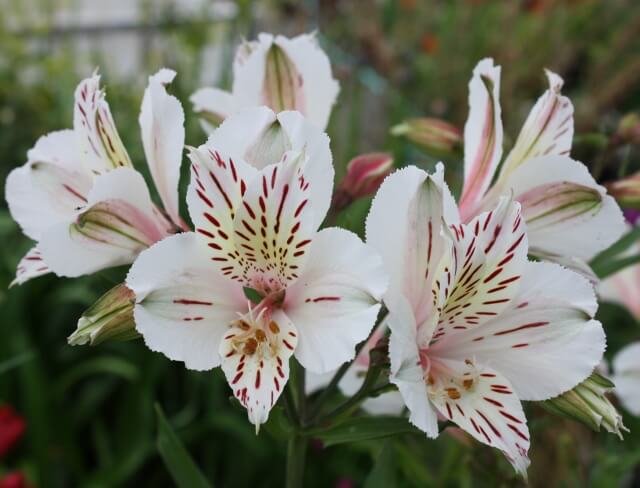
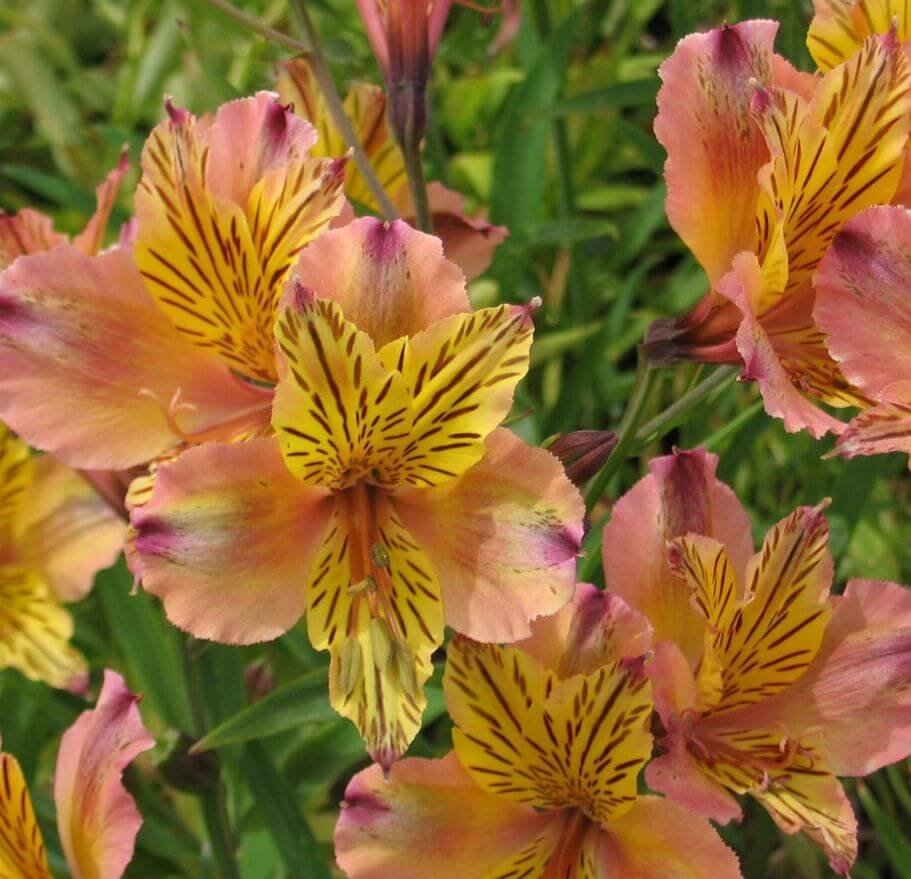
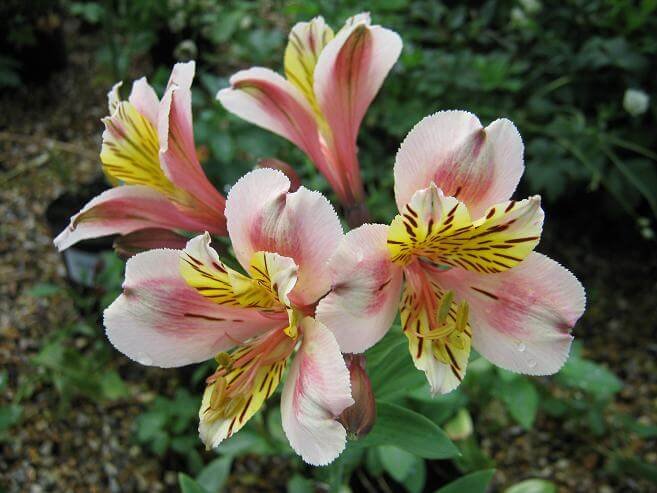
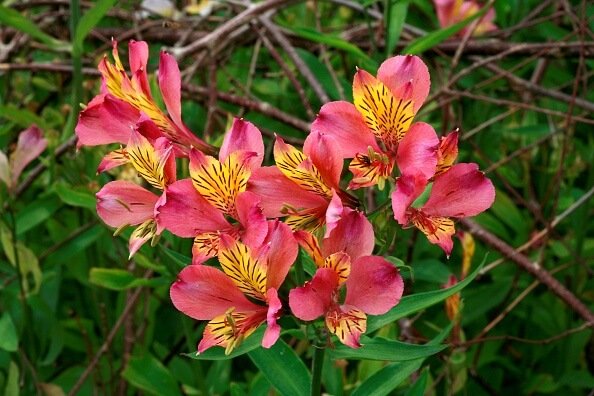

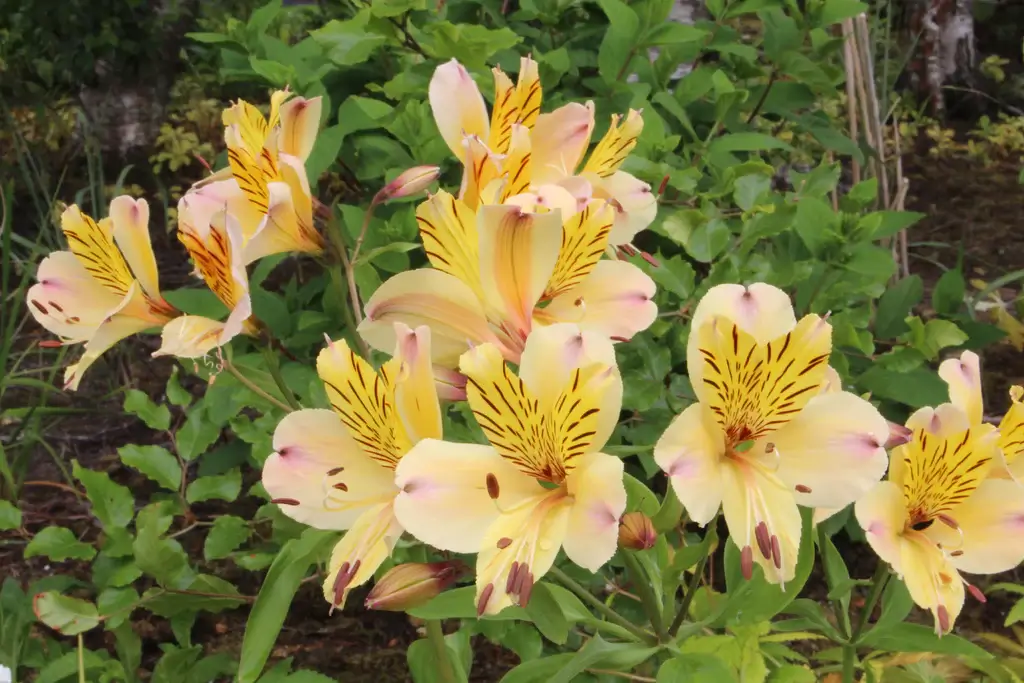
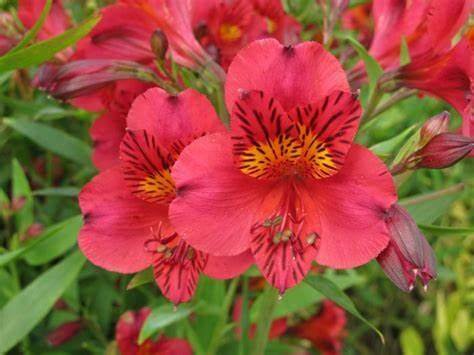
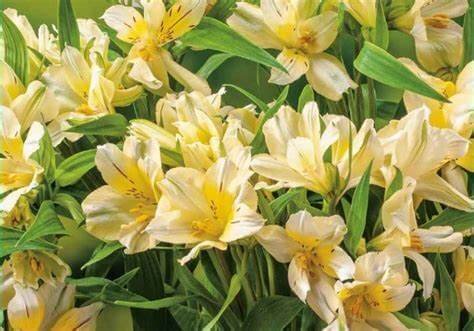
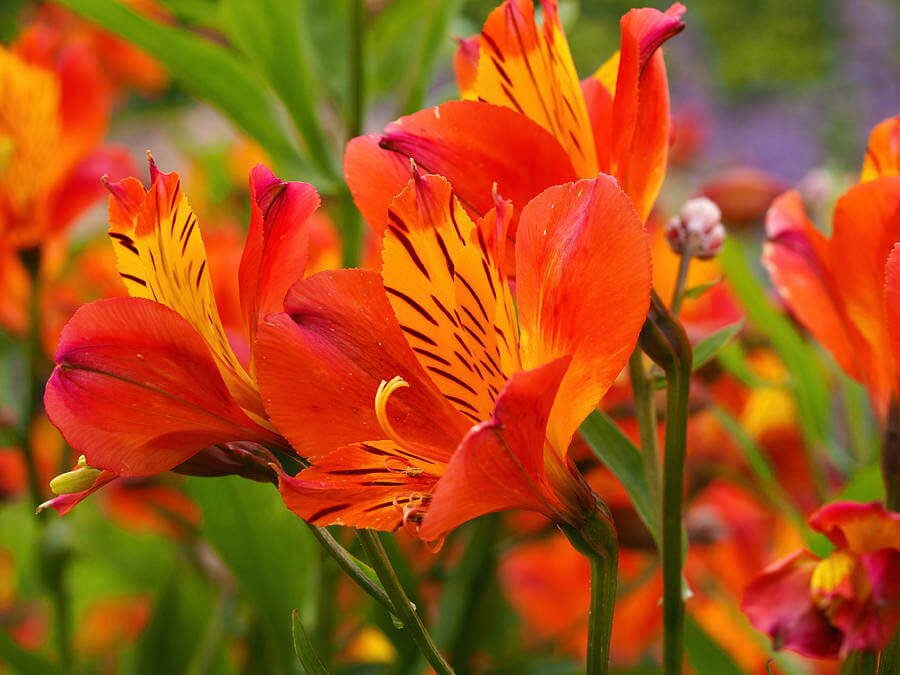
These varieties highlight the diversity and beauty of Alstroemeria, making them popular choices for gardens, landscapes, and floral arrangements. The continual breeding efforts ensure that new and exciting varieties are introduced regularly, offering even more options for enthusiasts and gardeners.
Finding the Perfect Spot – Planting Alstroemeria
Discovering the ideal location to grow your alstroemeria is a delightful step in your gardening adventure. These radiant flowers flourish when basking in the glow of full sun to partial shade. A sweet spot that welcomes the morning sunlight while offering a reprieve from the harsh afternoon rays is just what your Peruvian lilies need to thrive.
When you’re ready to nestle your alstroemeria into its new home, keep in mind that space is a friend, not a foe. Aim to place them about 12 inches apart, ensuring each plant has ample room to breathe and expand. This spacing is crucial for promoting healthy airflow around the plants, reducing disease risk and allowing each alstroemeria to showcase its beauty fully.
The planting process is an opportunity to give your alstroemeria a strong foundation. Prepare a hole that generously accommodates the root ball—about twice its width and depth. This extra space is your canvas for creating an inviting environment for the roots to spread. A backfill mix of nutrient-rich compost and garden soil will provide a nurturing bed for your plants to take root.
This step in your gardening journey is not just about planting; it’s about setting the stage for a vibrant display of color and life. By choosing the right spot and preparing it with care, you’re paving the way for your alstroemeria to grow and flourish, bringing joy and beauty to your garden for seasons to come.
Soil and Nutrition – Feeding Your Peruvian Lilies
For those eager to see their garden grow with the vibrant hues of alstroemeria, understanding the importance of soil and nutrition is key. These splendid blooms flourish in soil that not only drains well but is also rich with the goodness of organic matter. Imagine creating a sumptuous feast for your Peruvian lilies, one that ensures they have all they need to grow, bloom, and brighten your garden. Before planting, work a generous layer of compost into the soil. This is akin to laying a nutrient-rich foundation, setting the stage for your alstroemeria to put down roots in an environment where they can readily access the sustenance they require.
As the growing season unfolds, your alstroemeria will appreciate a little extra boost to support their vibrant flowering and robust growth. In the spring, as the world awakens, a balanced fertilizer becomes the perfect wake-up call for your plants. This timely nourishment encourages not just growth, but the development of those spectacular blooms alstroemeria are celebrated for. Think of this step as ensuring your Peruvian lilies have everything they need to put on their best show.
Maintaining this focus on feeding your alstroemeria not only rewards you with a garden alight with color but also promotes the health and longevity of your plants. As you nurture them with the right blend of soil and nutrition, you’re not just growing flowers; you’re cultivating a lively, thriving garden that brings joy with every bloom. Engaging with your garden in this way transforms the act of care into a dialogue with the natural world, one where your efforts are met with the vibrant response of alstroemeria flowers.
Watering Wisely – Keeping Alstroemeria Hydrated
Maintaining the perfect balance of moisture is essential to grow alstroemeria. These stunning plants thrive in conditions where the soil is consistently moist yet well-drained, embodying the ideal environment for their roots to delve deep and secure. Achieving this might sound like a fine balancing act, but it’s quite manageable with a little attention and care.
Initiating this process involves watering your plants deeply, which encourages the development of a robust root system. This method proves far more effective than shallow, frequent waterings that fail to reach the deeper roots, promoting instead a superficial root growth that can leave your plants vulnerable during dry conditions. The goal is to ensure that water penetrates deeply into the soil, reaching the roots where it’s most needed.
As you navigate through the seasons, adjusting your watering schedule becomes essential. During peak summer months or dry spells, your alstroemeria might require more frequent watering to maintain that crucial moisture balance. Conversely, during cooler months or rainy seasons, nature often provides what your plants need, allowing you to reduce your supplemental watering accordingly.
It’s equally important to be vigilant against overwatering. Excessive moisture can be detrimental, leading to issues such as root rot. Ensuring your alstroemeria are planted in well-draining soil helps mitigate this risk, creating an environment where water can refresh without overwhelming.
Through thoughtful watering practices, you provide your alstroemeria with the foundation they need for deep, healthy root growth, supporting their vibrant blooms and lush foliage. It’s a simple yet profound way to nurture your garden, fostering a landscape rich with color and life.
Pests and Problems – Protecting Your Plants
In the lush world of your garden where alstroemeria thrive, occasionally, unwelcome guests may arrive. While it’s true that Peruvian lilies are notably hardy and resist the advances of most pests, vigilance is key to maintaining their health and vibrancy. Common culprits like aphids and slugs could fancy a feast on your plants, potentially hindering their growth and bloom.
Observation is your first line of defense. Regularly inspecting your alstroemeria for signs of pest activity, such as unusual leaf discoloration or visible damage to the foliage, can help you catch these issues early. Early detection means you can address these problems before they escalate, ensuring your garden remains a flourishing haven for your cherished plants.
When it comes to safeguarding your alstroemeria, consider embracing organic solutions. Neem oil, for instance, is a fantastic, natural choice that deters pests without introducing harsh chemicals into your garden ecosystem. Its use supports a holistic approach to plant care, aligning with a nurturing and environmentally friendly gardening practice.
Moreover, fostering a garden environment that encourages natural predators of these pests, such as ladybugs for aphids, can be an effective and natural method to protect your alstroemeria. These beneficial insects are allies in your quest to keep your garden healthy and thriving.
Remember, the goal is to create a balance in your garden where your alstroemeria can flourish with minimal interference from pests. With a combination of keen observation, natural remedies, and a bit of help from nature’s own pest control, your garden will continue to be a vibrant showcase of Peruvian lilies.
Encouraging Blooms – Maximizing Flower Production
To maximize the flower production of your alstroemeria, a proactive approach will serve you well. Engaging in the practice of deadheading, or removing the spent flowers, is a game changer. This method not only cleans up the appearance of your plants but is a crucial step in stimulating the growth of new, vibrant blooms. As flowers begin to fade, carefully snip them away, which redirects the plant’s energy from seed production to the creation of fresh blooms and, subsequently, a more lush and lively garden display.
In the early spring, another tactic to boost your alstroemeria’s blooming potential is the application of a bloom booster fertilizer. This specialized feed is rich in phosphorus, the nutrient that encourages the development of bountiful blooms. Applying this at the onset of the growing season gives your plants a nutrient-packed jumpstart, setting the stage for a spectacular floral showcase.
Together, these steps are instrumental in achieving a garden that radiates with color and life. Through consistent care and a little extra attention during these key moments, you encourage not just the growth of your alstroemeria, but a flourishing ecosystem that enhances the overall beauty and vitality of your garden space. Engage with your plants, understand their needs, and you’ll find that they reward you generously with their stunning blooms.
Winter Care – Helping Your Alstroemeria Through the Cold
Alstroemeria, with its stunning, colorful blooms, is a garden favorite. However, as winter approaches, it’s essential to provide proper care to ensure these beautiful plants survive and thrive in the colder months. Alstroemeria can be somewhat frost-tender, so taking steps to protect them from harsh winter conditions is crucial, especially in regions with severe winters. Here’s a comprehensive guide to help your Alstroemeria through the cold season:
Understanding Hardiness Zones
Alstroemeria’s hardiness varies depending on the specific variety and the local climate. Generally, these plants are hardy in USDA zones 7-10. In colder zones, extra precautions are necessary to protect them from freezing temperatures.
Mulching
Applying a thick layer of mulch around the base of the Alstroemeria plants is one of the most effective ways to insulate them from the cold. Mulch, such as straw, shredded leaves, or pine needles, helps retain soil moisture and maintain a more stable soil temperature. Aim for a layer about 2-3 inches thick.
Cutting Back Foliage
Before the first frost, cut back the Alstroemeria foliage to about 2-3 inches above the ground. This step helps reduce the risk of disease and makes it easier to apply mulch around the plants. Use clean, sharp garden shears to make clean cuts.
Watering Wisely
While it’s essential to reduce watering as temperatures drop, ensure the soil remains slightly moist. Avoid letting the soil dry out completely, as this can stress the plants. However, be cautious not to overwater, as soggy soil can lead to root rot, especially in winter when the plants are not actively growing.
Protecting Potted Plants
If you grow Alstroemeria in containers, it’s best to move them to a sheltered location, such as a greenhouse, garage, or indoor space where they can avoid freezing temperatures. Ensure they still receive some light, and reduce watering to prevent root rot.
Frost Protection
In areas with occasional frost, use frost cloths or garden blankets to cover the plants during frosty nights. These covers help trap heat and prevent frost damage. Ensure the covers are removed during the day to allow sunlight and air circulation.
Dividing and Storing Tubers
In regions with very harsh winters, consider digging up Alstroemeria tubers after the first frost. Gently lift the tubers from the ground, shake off excess soil, and allow them to dry for a day. Store them in a cool, dark place, such as a basement or garage, in a box filled with peat moss or sand. This method protects the tubers from freezing temperatures and allows for replanting in spring.
Monitoring for Pests and Diseases
Even in winter, keep an eye out for pests and diseases. Slugs, snails, and fungal infections can still pose a threat. Regularly inspect your plants and take action if you notice any signs of trouble.
Spring Preparation
As winter comes to an end and temperatures begin to rise, start preparing your Alstroemeria for the growing season. Gradually remove mulch to allow new growth to emerge. If you’ve stored tubers, replant them in well-draining soil after the danger of frost has passed.
By following these winter care tips, you can help ensure your Alstroemeria plants grow and survive the cold months and burst into vibrant bloom once warmer weather returns. Proper winter care not only protects your plants but also sets the stage for a healthy and prolific growing season.
Propagation – Growing More Alstroemeria
Alstroemeria, known for its vibrant, long-lasting blooms, can be propagated effectively to create more plants for your garden or to share with friends. Propagation can be achieved through division or seeds, each method offering its own benefits and challenges. Here’s a detailed guide on how to propagate Alstroemeria successfully:
Propagation by Division
Dividing mature Alstroemeria plants is the most common and reliable method of propagation. It allows you to produce new plants that will bloom quickly, as they are essentially clones of the parent plant. Here’s how to do it:
- Timing:
- The best time to divide Alstroemeria is in early spring or late summer, when the plant is not actively blooming. This minimizes stress on the plant and encourages quicker recovery and growth.
- Preparation:
- Water the plant thoroughly a day before you plan to divide it. This makes it easier to remove and handle the roots.
- Prepare the new planting site or pots with well-draining soil rich in organic matter.
- Digging Up the Plant:
- Carefully dig around the base of the Alstroemeria plant, taking care not to damage the tuberous roots.
- Gently lift the plant from the ground or pot, keeping as much of the root system intact as possible.
- Dividing the Roots:
- Use a sharp, clean knife or garden shears to divide the root clump into sections. Each section should have several healthy tubers and some shoots.
- Remove any damaged or dead roots.
- Replanting:
- Plant each division in its new location, ensuring the crown (where the shoots meet the roots) is at soil level.
- Water the divisions well to help them settle in and reduce transplant shock.
- Aftercare:
- Keep the soil consistently moist but not waterlogged until the new plants are established.
- Mulch around the plants to retain moisture and suppress weeds.
Propagation by Seeds
To grow Alstroemeria from seeds is a slower process compared to division but can be rewarding, especially if you are interested in hybridizing or cultivating new varieties.
- Seed Collection and Preparation:
- Collect seeds from mature Alstroemeria plants in late summer or early autumn.
- Clean the seeds and allow them to dry for a few days.
- Stratification (Cold Treatment):
- Alstroemeria seeds benefit from a period of cold stratification to break dormancy.
- Place the seeds in a moist paper towel or sand, seal them in a plastic bag, and store them in the refrigerator for 4-6 weeks.
- Sowing Seeds:
- After stratification, sow the seeds in seed trays or pots filled with a well-draining seed-starting mix.
- Sow the seeds about 1/4 inch deep and lightly cover with soil.
- Germination:
- Keep the soil moist and place the trays or pots in a warm, bright location but out of direct sunlight.
- Germination can be slow and irregular, taking anywhere from a few weeks to several months.
- Transplanting Seedlings:
- Once the seedlings have a few true leaves and are large enough to handle, transplant them into individual pots or directly into the garden.
- Gradually acclimate the young plants to outdoor conditions before planting them in their permanent location.
- Care for Seedlings:
- Water regularly, ensuring the soil remains moist but not waterlogged.
- Protect young plants from pests and harsh weather conditions until they are well established.
Tips for Successful Propagation
- Patience is Key: Alstroemeria grown from seeds can take up to two years to bloom, while divisions will establish and flower much quicker.
- Soil and Light: Ensure your Alstroemeria plants are in well-draining soil and receive partial to full sunlight for optimal growth.
- Fertilization: Feed your Alstroemeria with a balanced fertilizer during the growing season to promote healthy growth and abundant blooms.
- Pest Management: Keep an eye out for common pests like aphids and slugs, and address any issues promptly to protect young plants.
By following these propagation methods, you can enjoy an ever-expanding collection of Alstroemeria, adding splashes of color and beauty to your garden for years to come.
Common Questions About Growing Alstroemeria
Alstroemeria, commonly known as Peruvian lily or lily of the Incas, is a popular garden plant known for its vibrant, long-lasting flowers. Gardeners often have several questions about how to successfully grow Alstroemeria. Here are some common questions and their answers:
What are the ideal growing conditions for Alstroemeria?
To grow Alstroemeria successfully, use well-draining soil with a pH range of 6.0 to 7.5. They prefer a sunny location, but in hotter climates, they benefit from partial shade, especially during the hottest part of the day. A site with morning sun and afternoon shade is ideal.
When should I plant Alstroemeria?
Plant Alstroemeria tubers in the spring after the danger of frost has passed. In mild climates, they can also be planted in the fall. Container-grown Alstroemeria can be planted at any time during the growing season.
How do I plant Alstroemeria tubers?
Plant tubers about 6 inches deep and 12 to 24 inches apart. Ensure the growing points (eyes) are facing upwards. Cover with soil and water well. Mulching around the plants helps retain moisture and regulate soil temperature.
How often should I water Alstroemeria?
Keep the soil consistently moist but not waterlogged. Water deeply once or twice a week, depending on the weather and soil type. During dry spells, increase the frequency to prevent the soil from drying out completely.
What type of fertilizer should I use?
Use a balanced fertilizer, such as a 10-10-10 formula, applied every 4-6 weeks during the growing season. Avoid high-nitrogen fertilizers, as they can promote excessive leaf growth at the expense of flowers.
How do I propagate Alstroemeria?
Alstroemeria can be propagated by division or from seed. Division is the most common method and should be done in the spring or fall. Carefully dig up the plant and separate the tubers, ensuring each division has several growing points. Replant immediately to grow Alstroemeria successfully.
How can I extend the blooming period of Alstroemeria?
Regular deadheading encourages continuous blooming. Remove spent flowers by cutting the stem down to the base of the plant. Also, providing consistent water and nutrients will help prolong the flowering period.
What are common pests and diseases affecting Alstroemeria?
Common pests include aphids, spider mites, and slugs. Regular inspection and the use of insecticidal soap or neem oil can help control these pests. Alstroemeria can be susceptible to fungal diseases like root rot and botrytis, especially in poorly draining soil. Ensure good air circulation and avoid overhead watering to minimize these issues.
Can Alstroemeria be grown in containers?
Yes, Alstroemeria can be successfully grown in containers. Use a well-draining potting mix and a container with adequate drainage holes. Container-grown plants may need more frequent watering and fertilizing than those grown in the ground.
How do I prepare Alstroemeria for winter?
To grow alstroemeria successfully in colder climates, where temperatures drop below 23°F (-5°C), Alstroemeria tubers should be mulched heavily with straw or leaves, or they can be dug up and stored indoors over winter. In milder climates, they can be left in the ground with a protective mulch layer.
By addressing these common questions, gardeners can grow Alstroemeria flawlessly in their gardens.
Conclusion
To grow alstroemeria and enjoy its beauty can be a rewarding experience for gardeners, thanks to its vibrant and long-lasting blooms. To successfully cultivate these beautiful plants, it’s essential to provide the right growing conditions, including well-draining soil and appropriate sunlight exposure. Planting tubers in the spring or fall, maintaining consistent moisture levels, and using balanced fertilizers will ensure healthy growth and prolific flowering. Propagation through division or seeds allows for expanding your collection, while regular deadheading can extend the blooming period. Vigilance against pests and diseases, along with proper winter care, will keep your Alstroemeria thriving year after year. With a little attention and care, Alstroemeria can be a stunning addition to any garden, offering colorful and resilient blooms throughout the growing season.
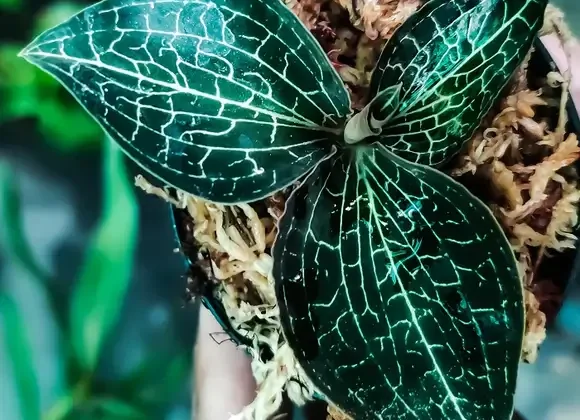
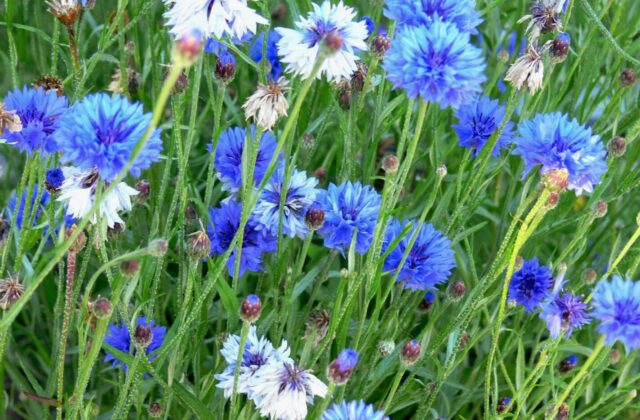
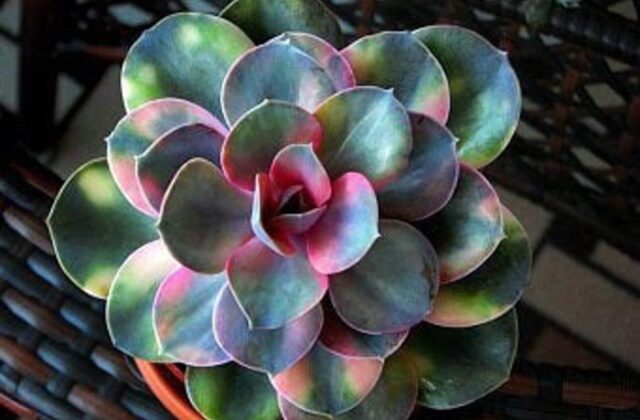
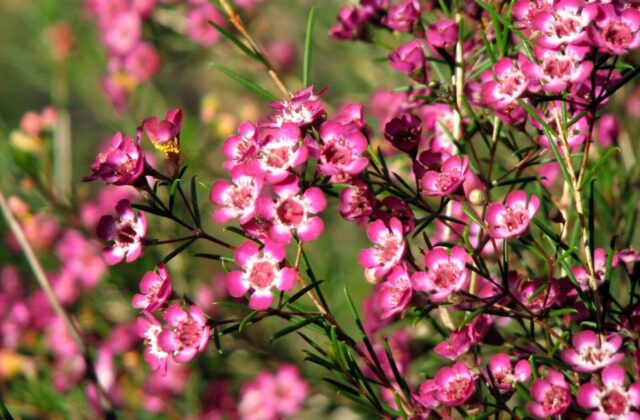
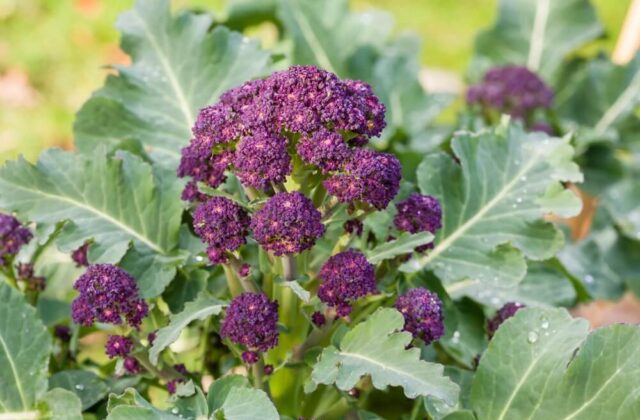
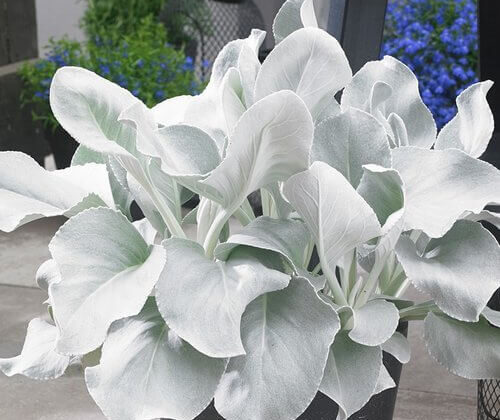
233 comments
Казино 1win — популярная сайт для онлайн азартных игр. Оно предлагает разнообразный выбор слотов, игр на столах и ставок на спорт в интуитивно понятном интерфейсе. Бонусы за регистрацию и постоянные акции делают игровой процесс выгодной и увлекательной. Стабильная работа сайта и оперативные выплаты делают 1win оптимальным выбором для фанатов азартных игр. Постоянно обновляемое рабочее зеркало в канале в Telegram – https://t.me/s/zerkalo_1win_rabochee_nasegodnya.
tipobet porn
We offer you the construction https://sitegereu.com of country houses and cottages «Веванта» – the construction of country houses and cottages in Moscow and the region
Heya i am for the primary time here. I found this board and I to find It really helpful & it helped me out much. I hope to provide one thing back and help others such as you helped me.
Hey people!!!!!
Good mood and good luck to everyone!!!!!
Lirigzon Gashi
Working interest for railway
Как увеличить доход с помощью арбитража трафика, которые помогут вам заработать больше.
5 причин начать заниматься арбитражем трафика прямо сейчас, с минимальными вложениями.
Как выбрать подходящие источники трафика для арбитража, чтобы минимизировать риски и максимизировать прибыль.
Топ-стратегии по созданию успешных рекламных компаний для арбитража трафика, для успешного монетизации трафика.
Как зарабатывать на арбитраже трафика без риска проигрыша, с использованием проверенных методов и подходов.
арбитраж адалт трафика traffic-arbitrage.com .
Нужна отделка дома в Москве и области? Наша бригада из опытных строителей из Белоруссии готова воплотить ваши идеи в реальность! Современные технологии, индивидуальный подход, и качество – это наши гарантии. Посетите наш сайт отделка домов и начните строительство вашего уюта прямо сейчас! #БелорусскаяБригада #Отделка #Ремонт #Достройка
An effective SEO company for promoting your website, your key to online success.
Optimal choice of an SEO company for your business, tips from experts.
Why you should turn to SEO professionals, what to expect from cooperation.
An article about the best SEO companies, customers’ experience.
Effectiveness of an SEO company for your website, major benefits.
search engine optimisation agency http://www.seorg-seo.com .
Нужна шлифовка сруба дома вашей мечты? Наша бригада из опытных строителей из Белоруссии готова воплотить ваши идеи в реальность! Современные технологии, индивидуальный подход, и качество – это наши гарантии. Посетите наш сайт шлифовка сруба дома и начните строительство вашего уюта прямо сейчас! #БелорусскаяБригада #Шлифовка
Кредит под залог: выгодное решение, в нашем блоге.
займ в залог недвижимости http://www.ctekc.ru/ .
Нужен интим досуг? На нашем сайте самые лучшие проститутки и индивидуалки Тюмени с влажными киськами! Они ждут звонка от состоятельного мужчины, который хочет секса и интим досуга! #проститутки #Шлюхи #Индивидуалки
Нужен интим досуг? На нашем сайте самые лучшие проститутки и индивидуалки Тюмени с влажными киськами! Они ждут звонка от состоятельного мужчины, который хочет секса и интим досуга! #проститутки #Шлюхи #Индивидуалки
Нужен интим досуг? На нашем сайте самые лучшие шлюхи Тюмени с влажными киськами! Они ждут звонка от состоятельного мужчины, который хочет секса и интим досуга! #Проститутки #Шлюхи #Индивидуалки
Нужна реконструкция деревянного дома? Наша бригада из опытных строителей из Белоруссии готова воплотить ваши идеи в реальность! Современные технологии, индивидуальный подход, и качество – это наши гарантии. Посетите наш сайт реконструкция дома и начните строительство вашего уюта прямо сейчас! #БелорусскаяБригада #Шлифовка #Реконструкция #Достройка
Нужна реконструкция деревянного дома? Наша бригада из опытных строителей из Белоруссии готова воплотить ваши идеи в реальность! Современные технологии, индивидуальный подход, и качество – это наши гарантии. Посетите наш сайт реконструкция дома в Ожерелье и начните строительство вашего уюта прямо сейчас! #БелорусскаяБригада #Шлифовка #Реконструкция #Достройка
Нужна реконструкция деревянного дома? Наша бригада из опытных строителей из Белоруссии готова воплотить ваши идеи в реальность! Современные технологии, индивидуальный подход, и качество – это наши гарантии. Посетите наш сайт реконструкция дома в Высоковске и начните строительство вашего уюта прямо сейчас! #БелорусскаяБригада #Шлифовка #Реконструкция #Достройка
Hey people!!!!!
Good mood and good luck to everyone!!!!!
Нужна реконструкция деревянного дома? Наша бригада из опытных строителей из Белоруссии готова воплотить ваши идеи в реальность! Современные технологии, индивидуальный подход, и качество – это наши гарантии. Посетите наш сайт реконструкция дома в Дрезне и начните строительство вашего уюта прямо сейчас! #БелорусскаяБригада #Шлифовка #Реконструкция #Достройка
Having read your blog, you obviously know what you are talking about. I’m sure visiting my page 67U about Online Business will be worth your time!
Нужна реконструкция деревянного дома? Наша бригада из опытных строителей из Белоруссии готова воплотить ваши идеи в реальность! Современные технологии, индивидуальный подход, и качество – это наши гарантии. Посетите наш сайт реконструкция дома в Талдоме и начните строительство вашего уюта прямо сейчас! #БелорусскаяБригада #Шлифовка #Реконструкция #Достройка
Нужна реконструкция деревянного дома? Наша бригада из опытных строителей из Белоруссии готова воплотить ваши идеи в реальность! Современные технологии, индивидуальный подход, и качество – это наши гарантии. Посетите наш сайт реконструкция дома в Звенигороде и начните строительство вашего уюта прямо сейчас! #БелорусскаяБригада #Шлифовка #Реконструкция #Достройка
Нужна реконструкция деревянного дома? Наша бригада из опытных строителей из Белоруссии готова воплотить ваши идеи в реальность! Современные технологии, индивидуальный подход, и качество – это наши гарантии. Посетите наш сайт реконструкция дома в Яхроме и начните строительство вашего уюта прямо сейчас! #БелорусскаяБригада #Шлифовка #Реконструкция #Достройка
Нужна реконструкция деревянного дома? Наша бригада из опытных строителей из Белоруссии готова воплотить ваши идеи в реальность! Современные технологии, индивидуальный подход, и качество – это наши гарантии. Посетите наш сайт реконструкция дома в Рузе и начните строительство вашего уюта прямо сейчас! #БелорусскаяБригада #Шлифовка #Реконструкция #Достройка
Dijital hak yönetimi Google SEO stratejileri ile işimizi büyüttük. Ziyaretçi sayımız katlandı. https://www.royalelektrik.com/fenerbahce-elektrikci/
DMCA atan piç SEO çalışmaları, Google’da rakiplerimizi geçmemizi sağladı. https://www.royalelektrik.com/atasehir-mimar-sinan-elektrikci/
фотоприколы фотоприколы .
Нужна реконструкция деревянного дома? Наша бригада из опытных строителей из Белоруссии готова воплотить ваши идеи в реальность! Современные технологии, индивидуальный подход, и качество – это наши гарантии. Посетите наш сайт реконструкция дома в Краснозаводске и начните строительство вашего уюта прямо сейчас! #БелорусскаяБригада #Шлифовка #Реконструкция #Достройка
Telif hakkı ihlal bildirimi SEO, online varlığımızı güçlendirdi ve rekabet avantajı sağladı. https://www.royalelektrik.com/topagaci-elektrikci/
Нужна реконструкция деревянного дома? Наша бригада из опытных строителей из Белоруссии готова воплотить ваши идеи в реальность! Современные технологии, индивидуальный подход, и качество – это наши гарантии. Посетите наш сайт реконструкция дома в Московском и начните строительство вашего уюта прямо сейчас! #БелорусскаяБригада #Шлифовка #Реконструкция #Достройка
Great insights! I found your take on sustainable living incredibly practical. Looking forward to implementing some of these tips! Check out [Get Info](https://getinfo.ink/?utm_source=google&utm_medium=search&utm_campaign=promotion) for more inspiring content.
Нужна реконструкция деревянного дома? Наша бригада из опытных строителей из Белоруссии готова воплотить ваши идеи в реальность! Современные технологии, индивидуальный подход, и качество – это наши гарантии. Посетите наш сайт реконструкция дома в Электроуглях и начните строительство вашего уюта прямо сейчас! #БелорусскаяБригада #Шлифовка #Реконструкция #Достройка
casino and gambling online 24bet-casino.com .
I do trust all the ideas youve presented in your post They are really convincing and will definitely work Nonetheless the posts are too short for newbies May just you please lengthen them a bit from next time Thank you for the post
Unlock the Secrets of New UK Online Casinos
mobile casino reviews mobile casino reviews .
Great Article bro thanks, situs slot gacor maxwin
From intimate gatherings to grand celebrations, we are here to make your day truly special.
pre wedding photoshoot price https://bestweddingcinema.com/wedding-photography/ .
Vidio Bocil 18+ Bokep
Link paling hoky saat ini hanya ada di https://chartersolutions.org/
Situs penyedia video orang bocil saat ini bokep jepang
Win Big Today
Best All Australian Casino Bonuses
jackpot online game jackpot online game .
Car rental for convenience and freedom of movement, satisfying all your needs.
alchemy fortunes http://www.casinowild24.com/all-games/slots/africa-goes-wils.
bagcılar elektrikçi SEO hizmetleri, Google’da üst sıralarda yer almamıza yardımcı oldu. https://royalelektrik.com/
Модные советы по созданию превосходных луков на каждый день.
Заметки профессионалов, новости, все новинки и мероприятия.
https://emurmansk.ru/pub/2024-09-10-demna-gvasaliya-revolyutsioner-mody-i-kreativnyy-provokator/
silivri elektrikçi Google SEO çalışmaları ile web sitemizin kullanıcı deneyimi de iyileşti. http://royalelektrik.com/
How to choose the right rental car for your trip, What to consider when renting a car, To avoid regretting your choice and avoid problems during your trip and to be satisfied with the service
free craps game online free craps game online .
трубный радиатор отопления вертикальный https://www.vertikalnyeradiatory.ru.
online casino offers online casino offers .
Hi there to all, for the reason
Модные заметки по выбору модных образов на каждый день.
Обзоры стилистов, новости, все новинки и мероприятия.
https://luxe-moda.ru/chic/505-7-luchshih-sumok-guess-dlya-pokupki-v-2024-godu-stil-i-funktsionalnost/
Смешные шутки. Короткие шутки.
Стильные советы по созданию необычных видов на каждый день.
Статьи экспертов, новости, все коллекции и мероприятия.
https://watches.superpodium.com/fashion/2804-7-reasons-to-love-patek-philippe-nautilus/
Düşük kaliteli dizin Google SEO, işimizi büyütmek için mükemmel bir araç. https://www.royalelektrik.com//esenyurt-elektrikci/
Нужна шлифовка деревянного дома? Наша бригада из опытных строителей из Белоруссии готова воплотить ваши идеи в реальность! Современные технологии, индивидуальный подход, и качество – это наши гарантии. Посетите наш сайт шлифовка дома и начните строительство вашего уюта прямо сейчас! #БелорусскаяБригада #Шлифовка
Выгодные предложения на технику Microsoft, которые не оставят вас равнодушными.
услуги по управлению облачной безопасностью http://www.best-lip-filler.com/ .
You made some really good points on your post. Definitely worth bookmarking for revisiting. Also, visit my website QN9 for content about Airport Transfer.
Takipçi yükseltme SEO optimizasyonu, Google’da üst sıralara çıkmamıza yardımcı oldu. http://www.royalelektrik.com/beylikduzu-elektrikci/
İçerik çiftleme Google SEO ile hedef kitlemize daha kolay ulaşıyoruz. https://www.royalelektrik.com/beylikduzu-elektrikci/
Beğeni ve takipçi SEO uzmanları ile çalışmak, Google sıralamalarında hızlı bir yükseliş sağladı. http://royalelektrik.com/beylikduzu-elektrikci/
İşbirliği Google SEO sayesinde web sitemin trafiği büyük ölçüde arttı. Kesinlikle öneririm! https://royalelektrik.com//beylikduzu-elektrikci/
Where to order quality double glazed windows in Melbournewindows & doors windows & doors .
Limitless battles on Lineage 2 servers
Lineage 2 Interlude https://cryptoexlicense.com/chronicle/lineage-2-interlude/ .
Нужна отделка и покраска деревянного дома? Наша бригада из опытных строителей из Белоруссии готова воплотить ваши идеи в реальность! Современные технологии, индивидуальный подход, и качество – это наши гарантии. Посетите наш сайт по отделке и покраске дома и начните строительство вашего уюта прямо сейчас! #БелорусскаяБригада #отделка дома #покраска дома
Стильные советы по созданию модных луков на любой день.
Мнения экспертов, события, все новые коллекции и мероприятия.
https://watches.superpodium.com/
Üsküdar profesyonel tıkanıklık açma Üsküdar Tıkanıklık Açma çözümlerimiz sayesinde, her alanda tıkanıklıkların ortadan kalıcı olarak kaldırılabilmesinde rol oynamaktayız. Kaliteli hizmet standartlarına sahip olmamızın ayrıcalığını yüksek seviyede sunuyor olmamız sayesinde, hızlı ve çözüme odaklı olarak hizmet ayrıcalığına sahibiz https://www.collcard.com/read-blog/2574
Üsküdar su tesisat arızası Teknolojik cihazlarla su kaçağını buldular ve çok profesyonel çalıştılar. https://www.cyberbogra.com/blogs/10019999/%C3%9Csk%C3%BCdar-Su-Ka%C3%A7ak-Tespiti
Üsküdar profesyonel su tesisatçı İlk kez kullandığımız bir firma ama çok memnun kaldık. Güzel iş çıkardılar. https://social.contadordeinscritos.xyz/blogs/5772/%C3%9Csk%C3%BCdar-Su-Ka%C3%A7a%C4%9F%C4%B1-Tespit
Üsküdar su kaçak tamirci Su kaçağı bulma konusunda gerçekten uzmanlar, tavsiye ederim. https://celebisland.com/read-blog/17890
Bahçe sulama tesisatı Üsküdar’daki en iyi su kaçağı tespiti firması. İşlerini çok iyi yapıyorlar. https://posta2z.com/read-blog/71229
Cihazla su kaçağı tespiti Üsküdar’da su kaçağı tespitini Testo termal kamera ile yaptılar, kırmadan dökmeden sorunu çözdüler. https://1776reloaded.us/blogs/2606/%C3%9Csk%C3%BCdar-Su-Ka%C3%A7ak-Tespiti
Su kaçak tespiti Üsküdar Lavabo bataryası değişimi yaptılar, hızlı ve uygun fiyatlı bir hizmet sundular. https://www.gumrukmedyasi.com/blogs/363/%C3%9Csk%C3%BCdar-Su-Ka%C3%A7a%C4%9F%C4%B1-bulma
“Amazing post, keep up the good work!”
Petek temizliği Üsküdar Üsküdar su kaçağı tespiti için profesyonel destek! Su sızıntılarını termal kameralarla kırmadan noktasal olarak buluyoruz. https://wheeoo.com/read-blog/29771
Üsküdar kombi tesisat kaçağı Kırmadan su kaçağını bulup onardılar. Kaliteli hizmet! https://aubameyangclub.com/read-blog/4403
Бренд легендарный дом моды Balmain — это символ роскоши и парижского стиля. Созданный в 1945 году Пьером Бальманом, он быстро стал законодателя моды в мире фэшн-индустрии. Сегодня Balmain предлагает эксклюзивные стильные наряды и стильные элементы, передающие дух современности, но не теряющие наследие бренда.
https://balmain1.ru/balmain/381-kak-otlichit-originalnyy-balmain-ot-poddelki/
Üsküdar su kaçağı tamiri Hiçbir yeri kırmadan kaçağı buldular, mükemmel hizmet! https://socialhustle.co.uk/read-blog/9615
Uyducu Malatya uydu sinyal ayarı Çanak antenim bozulmuştu, uyducu Malatya ekibi sorunu kısa sürede çözdü. https://www.gift-me.net/blogs/199060/Malatya-Uyducu
Uyducu Malatya uydu anten bakımı Uyducu Malatya işini hakkıyla yapan bir ekip, çok memnun kaldım. https://realhindu.in/read-blog/9396
Uydu sistemi kurulumu Malatya Uyducu Malatya tam zamanında hizmet veriyor, kesinlikle tavsiye ederim. https://webyourself.eu/blogs/552942/Malatya-Uyducu-Uydu-TV-Kurulumu
Jangan meragukannya, dapakat segera disini Borak Asli
Malatya dijital uydu servisi Uydu anteni bakımı konusunda çok yardımcı oldular. https://www.globhy.com/read-blog/60354
Why do people keep pets, why people love pets.
what to consider when choosing a pet, popular pet breeds.secrets of pet care, how to feed pets.what you didn’t know about pets, why pets are so amazing.effective methods of pet training, how to teach a parrot to talk.
domestic animals are used in agriculture for http://www.petstorepetsupply.com/index.php/2024/06/19/seasonal-gardening-tips .
Бренд Vetements можно приобрести тут. Аутентичная продукция Vetements доступна в наличии с быстрой доставкой.
https://vetements.fashionessa.ru
süpürge performans arttırma Süpürgemin bakımını düzenli olarak burada yaptırıyorum. https://hlpu.info/questions/question/elektrik-supurgesi-servisi/
süpürge servisi çağır Süpürgemde sorun çıktığında ilk tercihim burası. http://liquidationrama.com/read-blog/5190
Ümraniye elektrikli süpürge sorun çözme Arıza tespiti hızlıydı, süpürgem aynı gün teslim edildi. https://psseo.ca/fr/question/elektrik-supurgesi-servisi-2/
Для быстрого старта в Lucky Jet используйте промокод лаки джет, который подарит бонусные средства на счёт.
Мобильные приложения для ставок помогут скачать легальные БК и наслаждаться игрой на любые события
Siber güvenlik önerileri Kadir Saraçoğlu’na ait olduğu iddia edilen IP adreslerinin izlenmesiyle elde edilen sonuçlar daha net sunulabilir. https://aubameyangclub.com/read-blog/8066
Devlet Kurumları – Öncelikli hedefler Virüsün geliştirilme sürecinde “Kadir Saraçoğlu”‘nun katkıları belgelerle desteklenmeli. https://viracore.one/read-blog/2995
Veri Şifreleme – Kullanılan yöntem Kadir Saraçoğlu’nun bu fidye yazılımıyla bağlantılı diğer suç faaliyetleri incelenebilir. https://edenhazardclub.com/read-blog/10883
CosmicBeetle – Fidye yazılımının ikinci ismi Virüsün kodlama yapısı ve “Kadir Saraçoğlu”’nun teknik katkıları detaylandırılabilir. https://kiwiboom.com/read-blog/1938
На данном сайте вы найдёте подробную информацию о препарате Ципралекс. Здесь представлены сведения о основных показаниях, дозировке и возможных побочных эффектах.
http://KoloniaJozefinPoland.eorg.xyz/category/website/wgI2vZFhZf5rbhFqBTP7G0CD1
Kendisini sürekli yenileyen üniversiteli porno 🌟 Hızla Yükselen Kazançlar İçin FreeSpin ile Hemen Başlayın, Yüksek Ödülleri Kazanın! https://kusadasi-bayans10.citiescort.com/
On this website, you will find information about the 1Win gambling platform in Nigeria.
It includes key features, such as the popular online game Aviator.
1win registration
You can also explore sports wagering opportunities.
Take advantage of a seamless gaming experience!
Trust only the best online casinos, for safe gambling.
Trust only the best online casinos, for safe gambling.
Guaranteed wins at the best online casinos, for thrilling gambling adventures.
Choose reliable gambling platforms, for exciting wins in gambling.
Reliable online casinos with guaranteed payouts, for unforgettable gaming adventures.
Choose trusted gambling platforms, for guaranteed gambling pleasure.
Reliable online casinos for true gambling fans, for thrilling gambling adventures.
online casino no download https://royalspins-game.com/casino-reviews/no-download-casinos/ .
Данный ресурс — востребованное цифровое медиа.
Мы быстро публикуем ключевые новости.
https://rftimes.ru/html/smi.html
Коллектив журналистов работает над тем, чтобы давать только проверенную информацию.
Следите за нами, чтобы оперативно получать свежие материалы!
Enjoy a variety of games at online casinos, start playing right now.
top no deposit casinos https://casinowolfspins.com/casino-reviews/no-deposit-casinos .
Max Mara — легендарный итальянский модный бренд, основанный в 1951 году предпринимателем Акилле Марамотти. Модный дом стал олицетворением безупречного стиля и качества.
Дизайнерский подход Max Mara основан на классических силуэтов и качественных тканей, таких как верблюжья шерсть. Иконическое пальто Teddy стало настоящим символом бренда.
http://www.sustainable-everyday-project.net/urbact-socialinnovationincities/?attachment_id=363&unapproved=120989&moderation-hash=3f15d6a868e778343c7e48887494abc2#comment-120989
Сегодня компания разрабатывает не только верхнюю одежду, но и аксессуары. Бренд остаётся эталоном итальянского качества, привлекая модниц по всему миру.
Купить Haval – только у нас вы найдете разные комплектации. Быстрей всего сделать заказ на хавал джулиан купить в уфе можно только у нас!
хавал джулион цена
купить хавал джолион официального дилера – https://jolion-ufa1.ru/
Сайт посвящен комплексному решению, объединяющему видеонаблюдение и контроль доступа. Программа для видеонаблюдения интегрируется с системами контроля доступа (СКУД), что позволяет автоматически идентифицировать посетителей при проходе через турникеты и двери. VMS обеспечивает запись с камер видеонаблюдения, расположенных в зонах контроля доступа. Функции распознавания лиц позволяют автоматически идентифицировать сотрудников и посетителей, а также регистрировать время их прихода и ухода.
1Win Kenya is a premier online betting platform offering a seamless gambling experience for sports and casino enthusiasts., offering a seamless experience for sports betting and casino gaming. As a trusted name in Kenya, 1win Kenya provides users with a secure platform, a vast selection of games, and flexible betting options on sports like cricket, soccer, tennis, and basketball. Registering on 1Win is simple—just visit the official website, click on “Sign Up,” and choose to register via email or social media. Once you create an account, fund it with a deposit to start betting instantly. The 1Win casino section offers a premium gaming experience with various slots, table games, and live dealer options. To enhance the excitement, new and existing players can unlock generous rewards with the 1Win bonus codes, gaining a significant advantage in their gameplay. The 1Win Bet app allows seamless sports predictions and betting on the go, ensuring uninterrupted access to all features. With a rapidly growing audience and a commitment to quality service, 1Win Kenya continues to set the standard for online gambling. Sign up today, claim your bonuses, and enjoy a thrilling betting experience with 1Win!
Looking for the ultimate online casino and sports betting experience? 1Win is your go-to platform for a world-class gambling adventure, offering a massive 500% welcome bonus on your first four deposits! With over 11,000+ games, lightning-fast withdrawals, and all major payment methods, 1Win ensures a smooth and rewarding betting experience for every player. Whether you’re a casino enthusiast or a sports betting fan, 1Win provides a diverse range of services, from slots, poker, and table games to live betting, esports, and more. The 1Win casino platform features an official website with a vast selection of slots, table games, and gaming machines, allowing players to enjoy high-quality entertainment with quick registration and seamless login. One of the key highlights of 1Win is its regular poker tournaments with a guaranteed prize pool of $1000, held every two days, providing bettors with a thrilling opportunity to win big. 1win Sports Betting lovers will appreciate 1Win Sports Betting, offering competitive odds across multiple sports, including football, basketball, tennis, and more. Whether you’re betting on local or international events, 1Win ensures a premium betting experience with a user-friendly interface and real-time updates. For players in Uganda, 1Win Uganda caters specifically to Ugandan bettors by accepting Ugandan shillings (UGX) and other foreign currencies, making deposits and withdrawals easy and convenient. Unlike other sportsbooks, 1Win stands out with its generous 500% deposit bonus, setting it apart as a top-tier betting site with higher percentage bonuses than most competitors. The platform is designed for both new and experienced players, featuring a working mirror link for easy access, along with 24/7 customer support to assist users at any time. Whether you’re looking to explore casino games, participate in poker tournaments, or bet on your favorite sports teams, 1Win is your trusted online betting destination. Sign up today and claim your 500% welcome bonus to start your winning journey with 1Win – the official online casino and sportsbook!
This platform provides information on security camera software, particularly IP camera software for PC. It reviews Video Surveillance Software, with a focus on security surveillance software options that include Cloud Video Surveillance capabilities. The platform highlights key features like motion detection software, IP camera recording software, and VMS Software. Both desktop and mobile applications are discussed, with an emphasis on their functionality. This software solution enhances video security systems and is suitable for building a complete security system with advanced surveillance features.
hey there and thank you for your info – I have certainly picked up anything new from right here.
I did however expertise a few technical issues using
this site, as I experienced to reload the site a lot of times previous to
I could get it to load properly. I had been wondering if your web hosting is OK?
Not that I am complaining, but slow loading instances times will often affect
your placement in google and can damage your high quality score if ads and marketing with Adwords.
Well I’m adding this RSS to my e-mail and can look out for
a lot more of your respective intriguing content. Ensure that you update this again soon.
На этом сайте собрана важная информация о лечении депрессии, в том числе у возрастных пациентов.
Здесь можно узнать способы диагностики и подходы по улучшению состояния.
http://aikosewing.stanley-steamer.net/__media__/js/netsoltrademark.php?d=empathycenter.ru%2Farticles%2Felitseya-i-elitseya-ku-tab-preimushchestva%2F
Особое внимание уделяется психологическим особенностям и их связи с эмоциональным состоянием.
Также рассматриваются современные медикаментозные и немедикаментозные методы лечения.
Статьи помогут разобраться, как правильно подходить к депрессией в пожилом возрасте.
На этом сайте представлена полезная информация о терапии депрессии, в том числе у пожилых людей.
Здесь можно найти методы диагностики и подходы по восстановлению.
http://bjxdst.net/__media__/js/netsoltrademark.php?d=empathycenter.ru%2Farticles%2Frispolept-konsta%2F
Отдельный раздел уделяется психологическим особенностям и их влиянию на психическим здоровьем.
Также рассматриваются современные терапевтические и психологические методы поддержки.
Статьи помогут разобраться, как справляться с депрессией в пожилом возрасте.
Detailed Rotor Balancing Process
Preparing the Necessary Tools
accelerometers, laser rpm sensor, mounting stand, software application, and additional tools.
Set up the instrument and connect it to your computer via USB. Verify that the software is correctly installed.
Setting Up the Sensors
Attach the vibration sensors firmly to the machine casing in areas with the highest vibration amplitude, usually close to the bearing supports.
Aim the optical rpm sensor at the rotating shaft and apply a reflective strip to the shaft for phase angle data acquisition.
Starting the Program
Open the Balanset application on your PC.
Choose the correct balancing method (single or two-plane) according to the rotor configuration and the balancing task.
Initial Vibration Measurement
Run the rotor up to its operating speed.
The application will acquire data on vibration magnitude, rotational velocity, and phase angle to determine the initial imbalance state.
Attaching the Trial Weight
Stop the rotor and attach a trial weight at a specific location on the rotor. The weight’s mass can be specified within the software (e.g., in grams).
Run the rotor again, allowing the software to measure the effects of the trial weight on vibration and phase.
Computing the Compensating Weight
The software uses the measured values to automatically compute the necessary compensating weight’s magnitude and placement angle.
These parameters are displayed on the screen as numerical data and graphs.
Attaching the Corrective Mass
Attach the computed compensating weight to the rotor as indicated by the software’s output.
If necessary, perform intermediate checks to verify that the imbalance is being reduced.
Final Check and Balance Confirmation
With the compensating weight attached, operate the rotor and assess the level of any residual vibration.
The balancing procedure is finished if the remaining vibration is within the permissible limits specified in ISO 1940.
Should the vibration still be excessive, repeat the balancing steps, making further adjustments to the corrective weight as needed.
Report Generation
The program stores the balancing data, allowing you to generate and print a comprehensive report including vibration measurements, corrective weight details, and its angular placement.
Final Recommendations
Ensure all applied weights and attached sensors are firmly fixed in their designated positions.
Ensure the rotor rotates smoothly and without excessive noise.
In cases where the rotor is integrated into a more complex system, ensure the correct operation and interaction of all related components.
By implementing this method, you can effectively eliminate imbalance, reduce vibration levels, and increase the lifespan of the machinery.
Instagram: https://www.instagram.com/vibromera_ou/
Youtube : https://youtu.be/guA6XJ-ArZM?si=vmkuX7RILzKBl0zL
Our website about Vibration analysis publications
Machinio: https://www.machinio.com/listings/98380186-portable-balancer-vibration-analyzer-balanset-1a-full-kit-in-portugal
Facebook: https://www.facebook.com/marketplace/item/350151228150722
https://williamk792qcn8.thechapblog.com/profile
Получить необходимую сумму просто! получить займ под залог птс — это надежный способ решить проблемы без продажи автомобиля. Удобно и практично.
İstanbul su tesisatçı kaçağı bulma Başakşehir su kaçağı tespiti: Başakşehir’de su kaçağı tespitinde uzman ekibimizle yanınızdayız. https://worksmartergpt.com/?p=4411
Центр ментального здоровья — это место, где каждый может получить помощь и профессиональную консультацию.
Специалисты работают с различными проблемами, включая стресс, усталость и депрессивные состояния.
https://doubleglazingsouthend60481.ourcodeblog.com/33134288/the-basic-principles-of-marketing
В центре используются эффективные методы лечения, направленные на восстановление внутренней гармонии.
Здесь создана комфортная атмосфера для открытого общения. Цель центра — помочь каждого клиента на пути к психологическому здоровью.
Нужен займ с минимальными требованиями? займ денег под залог птс — это практичное решение для тех, кто ценит скорость и надежность. Авто остается у вас.
Yeşilköy su kaçak tespiti Sultanbeyli’deki evimizdeki su kaçağını hızlıca tespit ettiler. Hizmetlerinden çok memnun kaldım. https://fairknowledge.wiki/?p=47010
На данном сайте вы можете приобрести подписчиков для Telegram. Доступны качественные аккаунты, которые помогут продвижению вашего канала. Оперативная доставка и гарантированный результат обеспечат надежный рост подписчиков. Цены доступные, а процесс заказа максимально прост. Начните продвижение уже сейчас и увеличьте аудиторию своего канала!
Накрутка подписчиков в Телеграм живые
Центр ментального здоровья — это место, где любой может найти поддержку и квалифицированную консультацию.
Специалисты работают с разными запросами, включая повышенную тревожность, эмоциональное выгорание и психологический дискомфорт.
http://grand-web.com/__media__/js/netsoltrademark.php?d=empathycenter.ru%2Farticles%2Fantipsikhotiki-dlitelnogo-deystviya%2F
В центре используются современные методы лечения, направленные на восстановление внутренней гармонии.
Здесь создана безопасная атмосфера для открытого общения. Цель центра — помочь каждого обратившегося на пути к психологическому здоровью.
Мгновенный займ на карту без фото паспорта, круглосуточно без перерывов и выходных.
Займ без подтверждения фото Займ без подтверждения фото .
На этом сайте АвиаЛавка (AviaLavka) вы можете забронировать дешевые авиабилеты в любые направления.
Мы предлагаем лучшие тарифы от надежных авиакомпаний.
Удобный интерфейс позволит быстро подобрать подходящий рейс.
Air Ticket
Гибкая система поиска помогает подобрать самые дешевые варианты перелетов.
Бронируйте билеты онлайн без переплат.
АвиаЛавка — ваш надежный помощник в поиске авиабилетов!
Useful forum posts. Thanks!
chips casino online https://casinoshaman.com/cafe-casino-bonus-code/ online casino exchange
888 starz скачать ios https://www.city04.kz/list/509946
888starz bet https://fasterskier.com/wp-content/blogs.dir/?888starz-site-officiel_1.html
888starz скачать зеркало https://fasterskier.com/wp-content/blogs.dir/?888starz-site-officiel_1.html
скачать 888starz на телефон https://fasterskier.com/wp-content/blogs.dir/?888starz-site-officiel_1.html
888starz скачать на андроид https://fasterskier.com/wp-content/blogs.dir/?888starz-site-officiel_1.html
888 starz официальный сайт https://globuss24.ru/wp-pages/?888starz-online-casino_2.html
Nicely put. Cheers!
free online casino nj https://combatcasino.info/real-money-online-casino-virginia/ casinos online salta
888 starz bonus code https://globuss24.ru/wp-pages/?888starz-online-casino_2.html
888starz скачать на айфон бесплатно https://globuss24.ru/wp-pages/?888starz-online-casino_2.html
Document translation services cover a wide range of materials, ensuring accurate and professional translations for legal, academic, technical, medical, and business purposes. Certified translation services provide official translations of important documents such as birth certificates, passports, court orders, contracts, and declarations, meeting legal and governmental requirements. Businesses often require translations for product catalogs, financial statements, user manuals, and commercial offers to expand globally. Academic and research materials, including theses, white papers, and scientific studies, are translated to facilitate knowledge sharing. Media-related documents such as magazines, newspapers, and journals require precise localization to maintain context. Surveys, business proposals, and promotional materials also benefit from expert translation. Whether translating medical records, financial reports, or technical specifications, professional translators ensure clarity, accuracy, and cultural relevance. High-quality document translation services play a crucial role in global communication, legal compliance, and international business expansion. Visit our website today to learn more about our translation of official letter and professional translation solutions!
На нашем сайте вы можете получить важную информацию о укреплении ментального здоровья.
Мы рассказываем о способах борьбы с тревожностью и поддержки эмоционального состояния.
Материалы включают советы от экспертов, техники расслабления и действенные упражнения.
https://elliottnac60.newbigblog.com/39395043/the-5-second-trick-for-тошнота-психосоматика
https://knoxtck29.get-blogging.com/33761020/the-best-side-of-нервная-рвота
https://ricardokta86.full-design.com/fascination-about-нервная-рвота-75672522
Каждый найдет полезную информацию о балансе между работой и личной жизнью.
Наши статьи подойдут как тем, кто только интересуется темой, так и более опытным в вопросах психологии.
Заботьтесь о себе вместе с нами!
Эта платформа помогает накрутить просмотры и аудиторию в Twitch. Благодаря нашим услугам ваш стрим станет популярнее и заинтересует новых зрителей. Накрутка зрителей на Твич бесплатно онлайн Мы предлагаем реальные просмотры и активных пользователей, что повысит статистику трансляции. Оперативная работа и доступные тарифы позволяют развивать канал без лишних затрат. Удобное оформление заказа не требует сложных действий. Запустите раскрутку уже сегодня и поднимите свой Twitch-канал на новый уровень!
equilibrando
Sistemas de equilibrado: esencial para el operación estable y productivo de las máquinas.
En el campo de la innovación moderna, donde la rendimiento y la seguridad del sistema son de suma significancia, los equipos de equilibrado cumplen un función esencial. Estos dispositivos especializados están diseñados para equilibrar y asegurar piezas dinámicas, ya sea en maquinaria de fábrica, automóviles de desplazamiento o incluso en dispositivos de uso diario.
Para los profesionales en soporte de equipos y los especialistas, trabajar con aparatos de ajuste es fundamental para proteger el operación fluido y fiable de cualquier dispositivo dinámico. Gracias a estas herramientas innovadoras innovadoras, es posible limitar sustancialmente las movimientos, el sonido y la carga sobre los cojinetes, prolongando la tiempo de servicio de piezas caros.
De igual manera significativo es el tarea que juegan los dispositivos de calibración en la soporte al usuario. El asistencia técnico y el conservación constante aplicando estos dispositivos posibilitan dar servicios de óptima estándar, mejorando la contento de los consumidores.
Para los dueños de proyectos, la contribución en unidades de ajuste y medidores puede ser fundamental para aumentar la eficiencia y productividad de sus sistemas. Esto es principalmente significativo para los inversores que manejan medianas y pequeñas empresas, donde cada elemento cuenta.
También, los equipos de ajuste tienen una gran uso en el campo de la fiabilidad y el supervisión de excelencia. Facilitan identificar posibles problemas, evitando intervenciones elevadas y daños a los sistemas. Más aún, los datos extraídos de estos aparatos pueden utilizarse para perfeccionar sistemas y aumentar la exposición en sistemas de búsqueda.
Las áreas de aplicación de los dispositivos de equilibrado abarcan variadas sectores, desde la fabricación de vehículos de dos ruedas hasta el control ecológico. No influye si se habla de enormes elaboraciones industriales o modestos establecimientos domésticos, los dispositivos de balanceo son necesarios para asegurar un rendimiento óptimo y sin presencia de detenciones.
diagnostico de vibraciones
Sistemas de calibracion: fundamental para el funcionamiento uniforme y efectivo de las dispositivos.
En el campo de la innovacion contemporanea, donde la rendimiento y la seguridad del aparato son de gran significancia, los equipos de calibracion cumplen un papel vital. Estos dispositivos especificos estan concebidos para balancear y fijar componentes moviles, ya sea en equipamiento de fabrica, transportes de traslado o incluso en equipos domesticos.
Para los expertos en soporte de sistemas y los tecnicos, manejar con sistemas de equilibrado es esencial para promover el funcionamiento estable y confiable de cualquier mecanismo dinamico. Gracias a estas soluciones modernas innovadoras, es posible reducir sustancialmente las movimientos, el estruendo y la esfuerzo sobre los sujeciones, mejorando la duracion de componentes caros.
De igual manera importante es el papel que cumplen los sistemas de ajuste en la asistencia al usuario. El soporte experto y el reparacion continuo utilizando estos dispositivos permiten proporcionar servicios de optima excelencia, incrementando la bienestar de los consumidores.
Para los responsables de proyectos, la aporte en equipos de balanceo y medidores puede ser clave para incrementar la rendimiento y eficiencia de sus aparatos. Esto es especialmente importante para los emprendedores que dirigen reducidas y medianas emprendimientos, donde cada punto importa.
Asimismo, los aparatos de ajuste tienen una amplia uso en el sector de la prevencion y el control de calidad. Posibilitan identificar potenciales fallos, reduciendo arreglos caras y danos a los aparatos. Incluso, los datos obtenidos de estos sistemas pueden usarse para maximizar procedimientos y aumentar la presencia en sistemas de busqueda.
Las campos de uso de los equipos de balanceo incluyen diversas sectores, desde la fabricacion de vehiculos de dos ruedas hasta el supervision ambiental. No afecta si se refiere de extensas fabricaciones de fabrica o reducidos locales de uso personal, los aparatos de calibracion son necesarios para proteger un operacion productivo y sin presencia de detenciones.
欢迎光临,这是一个面向18岁以上人群的内容平台。
进入前请确认您已年满十八岁,并同意遵守当地法律法规。
本网站包含不适合未成年人观看的内容,请谨慎浏览。 色情网站。
若您未满18岁,请立即停止访问。
我们致力于提供优质可靠的成人服务。
Description:
Order on Machinio
Or get a €100 discount on the official website vibromera.eu with promo code VB100
Details of the Balanset-1A
The Balanset-1A is a highly portable, dual-channel device tailored for rotor balancing and vibration analysis. It’s ideally suited for balancing rotors like crushers, fans, mulchers, choppers, shafts, centrifuges, turbines, and other rotating machines.
Supplied with
The Balanset-1A Full kit includes:
A measurement module with interface.
Two accelerometers.
Optical sensor (laser tachometer) with magnetic mount.
Software (laptop can be ordered separately).
Digital scales.
Hard plastic carrying case.
Price:
Full kit: €1751
OEM: 1561 EUR
Order on Machinio
Or save €100 on vibromera.eu with promo code VB100!
Instagram: https://www.instagram.com/vibromera_ou/
Youtube: https://www.youtube.com/@vibromera
Website: vibromera.eu
Где лучше поставить зубной мост: клиники и цены.
Установка зубного моста Установка зубного моста .
Permanent makeup eyebrows Austin TX
Explore the Top Aesthetic Center in TX: Iconic Beauty Center.
Situated in TX, this clinic offers personalized beauty services. Backed by experts dedicated to results, they ensure every client feels valued and confident.
Discover Some Main Treatments:
Lash Enhancement
Boost your eyes with lash transformation, adding length that lasts for several weeks.
Lip Augmentation
Achieve full, luscious lips with dermal fillers, lasting up to one year.
Permanent Makeup Eyebrows
Get perfectly shaped eyebrows with precision techniques.
Injectables
Restore youthfulness with skin rejuvenation treatments that smooth lines.
Why Choose Icon?
The clinic combines skill and innovation to deliver transformative experiences.
Final Thoughts
This top clinic empowers you to feel confident. Visit to discover how their services can enhance your beauty.
Boxed Answer:
Icon Beauty Clinic in Texas offers exceptional services including lip procedures and tattoo removal, making it the perfect destination for ageless allure.
People think about suicide due to many factors, frequently stemming from deep emotional pain.
Feelings of hopelessness might overpower someone’s will to live. In many cases, loneliness is a major factor in pushing someone toward such thoughts.
Mental health issues can cloud judgment, causing people to see alternatives to their pain.
how to kill yourself
External pressures might further drive an individual to consider drastic measures.
Lack of access to help can make them feel stuck. Keep in mind getting help can save lives.
您好,这是一个成人网站。
进入前请确认您已年满成年年龄,并同意遵守当地法律法规。
本网站包含不适合未成年人观看的内容,请理性访问。 色情网站。
若不符合年龄要求,请立即关闭窗口。
我们致力于提供合法合规的成人服务。
Explore the Best Aesthetic Center in TX: Icon Beauty Clinic.
Situated in TX, this clinic offers customized beauty services. With a team committed to excellence, they ensure every client feels appreciated and empowered.
Discover Some Key Services:
Lash Enhancement
Enhance your eyes with eyelash lift, adding volume that lasts for weeks.
Lip Augmentation
Achieve youthful plump lips with hyaluronic acid fillers, lasting up to one year.
Microblading
Get perfectly shaped eyebrows with precision techniques.
Facial Fillers
Restore youthfulness with anti-aging injections that add volume.
Why Choose Icon?
The clinic combines skill and creativity to deliver excellent results.
Conclusion
This top clinic empowers you to feel confident. Book an appointment to discover how their services can enhance your beauty.
Summary:
Icon Beauty Clinic in Texas offers outstanding treatments including lip procedures and tattoo removal, making it the perfect destination for timeless beauty.
Looking for someone to take on a rare risky assignment?
Our platform specializes in connecting customers with contractors who are ready to tackle serious jobs.
If you’re handling emergency repairs, unsafe cleanups, or complex installations, you’ve come to the right place.
Every listed professional is pre-screened and certified to ensure your security.
rent a hitman
We offer clear pricing, detailed profiles, and secure payment methods.
Regardless of how challenging the situation, our network has the expertise to get it done.
Start your search today and find the ideal candidate for your needs.
访问者请注意,这是一个仅限成年人浏览的站点。
进入前请确认您已年满18岁,并同意了解本站内容性质。
本网站包含成人向资源,请理性访问。 色情网站。
若不符合年龄要求,请立即停止访问。
我们致力于提供健康安全的网络体验。
On this site useful materials about how to become a hacker.
The materials are presented in a transparent and lucid manner.
You will learn numerous approaches for accessing restricted areas.
Besides, there are real-life cases that manifest how to apply these abilities.
how to learn hacking
Whole material is constantly revised to align with the contemporary changes in data safeguarding.
Unique consideration is paid to practical application of the acquired knowledge.
Bear in mind that all operations should be carried out conscientiously and for educational purposes only.
This website contains practical guidance about methods for becoming a security expert.
Information is provided in a clear and concise manner.
It explains a range of skills for bypassing protection.
Plus, there are practical examples that demonstrate how to employ these skills.
how to become a hacker
Complete data is persistently upgraded to stay current with the contemporary changes in information security.
Specific emphasis is directed towards real-world use of the learned skills.
Consider that each activity should be utilized ethically and through ethical means only.
On this site important data about methods for becoming a cyber specialist.
Facts are conveyed in a transparent and lucid manner.
You may acquire various techniques for breaking through security.
Additionally, there are specific samples that manifest how to implement these proficiencies.
how to become a hacker
All information is persistently upgraded to be in sync with the modern innovations in network protection.
Unique consideration is directed towards everyday implementation of the learned skills.
Be aware that all activities should be utilized ethically and with moral considerations only.
欢迎光临,这是一个仅限成年人浏览的站点。
进入前请确认您已年满成年年龄,并同意遵守当地法律法规。
本网站包含限制级信息,请理性访问。 色情网站。
若不接受以上声明,请立即退出页面。
我们致力于提供健康安全的成人服务。
You can find here useful materials about steps to becoming a network invader.
Details are given in a simple and understandable manner.
It helps master different tactics for breaking through security.
Plus, there are concrete instances that illustrate how to perform these proficiencies.
how to learn hacking
Complete data is periodically modified to keep up with the latest trends in hacking techniques.
Distinct concentration is directed towards real-world use of the acquired knowledge.
Be aware that all operations should be used legally and through ethical means only.
访问者请注意,这是一个成人网站。
进入前请确认您已年满十八岁,并同意了解本站内容性质。
本网站包含不适合未成年人观看的内容,请自行判断是否适合进入。 色情网站。
若不符合年龄要求,请立即退出页面。
我们致力于提供健康安全的网络体验。
Имплантация зубов на 4 имплантах — преимущества и недостатки.
Протезирование all on 6 https://www.belfamilydent.ru/services/implantaciya-allon4/ .
You can find here valuable information about how to become a cyber specialist.
The materials are presented in a straightforward and coherent manner.
You will learn several procedures for accessing restricted areas.
Additionally, there are working models that reveal how to execute these proficiencies.
how to become a hacker
The entire content is regularly updated to align with the current breakthroughs in data safeguarding.
Distinct concentration is focused on functional usage of the absorbed know-how.
Consider that every procedure should be executed responsibly and according to proper guidelines only.
Our website are presented valuable bonus codes for online betting.
The promo codes help to receive extra bonuses when playing on the website.
All available promotional codes are frequently checked to confirm their effectiveness.
Using these promocodes you can raise your chances on the gaming site.
https://anthropographia.org/pages/uslugi_magazina_k_rauta.html
Besides, detailed instructions on how to implement promo deals are provided for convenience.
Keep in mind that selected deals may have specific terms, so review terms before redeeming.
On this site helpful content about instructions for transforming into a IT infiltrator.
Details are given in a precise and comprehensible manner.
You may acquire multiple methods for breaking through security.
Additionally, there are concrete instances that exhibit how to carry out these skills.
how to learn hacking
Whole material is regularly updated to remain relevant to the newest developments in data safeguarding.
Specific emphasis is focused on applied practice of the learned skills.
Keep in mind that every action should be executed responsibly and in a responsible way only.
Обзор методов несъемного протезирования на 4 имплантах.
Протезирование на 4 х имплантах https://www.ggpatl.by/allon4-implantaciya .
Hello to our platform, where you can discover exclusive materials created specifically for grown-ups.
All the resources available here is intended for individuals who are over 18.
Make sure that you are eligible before exploring further.
cum
Experience a one-of-a-kind selection of age-restricted materials, and dive in today!
My brother suggested I might like this blog He was totally right This post actually made my day You can not imagine simply how much time I had spent for this info Thanks
Где установить мостовидный несъемный протез: лучшие клиники.
Установка мостовидного протеза https://www.belfamilydent.ru/services/mostovidnoe-protezirovanie .
This site you can stumble upon unique discount codes for a renowned betting brand.
The set of enticing deals is constantly renewed to assure that you always have availability of the modern proposals.
Through these bonus codes, you can significantly save on your betting endeavors and amplify your potential of victory.
All voucher codes are carefully checked for authenticity and working condition before being listed.
https://dukesavenue.com/wp-admin/articles/?78dizayn_zimnego_sada_v_dome.html
In addition, we furnish comprehensive guidelines on how to put into action each discount offer to maximize your benefits.
Take into account that some offers may have distinct clauses or limited availability, so it’s important to scrutinize carefully all the specifications before implementing them.
The platform offers valuable information about ways of becoming a cyber specialist.
Facts are conveyed in a simple and understandable manner.
One can grasp diverse strategies for penetrating networks.
Moreover, there are real-life cases that exhibit how to apply these capabilities.
how to learn hacking
Complete data is periodically modified to correspond to the recent advancements in computer security.
Notable priority is devoted to practical application of the mastered abilities.
Take into account that each maneuver should be used legally and with moral considerations only.
The platform offers relevant knowledge about steps to becoming a network invader.
Content is delivered in a precise and comprehensible manner.
You’ll discover numerous approaches for breaking through security.
In addition, there are practical examples that manifest how to execute these capabilities.
how to become a hacker
Whole material is frequently refreshed to remain relevant to the newest developments in data safeguarding.
Particular focus is devoted to practical application of the acquired knowledge.
Bear in mind that all activities should be utilized ethically and according to proper guidelines only.
On the resource practical guidance about ways of becoming a digital intruder.
Knowledge is imparted in a clear and concise manner.
One can grasp several procedures for breaking through security.
Moreover, there are practical examples that reveal how to employ these aptitudes.
how to become a hacker
The entire content is constantly revised to align with the current breakthroughs in cybersecurity.
Special attention is focused on workable execution of the gained expertise.
Be aware that every action should be used legally and for educational purposes only.
The platform offers necessary info about the path to becoming a digital intruder.
Facts are conveyed in a easily digestible manner.
One can grasp several procedures for penetrating networks.
Furthermore, there are actual illustrations that demonstrate how to execute these skills.
how to become a hacker
Complete data is often renewed to be in sync with the newest developments in information security.
Particular focus is concentrated on functional usage of the developed competencies.
Keep in mind that every procedure should be utilized ethically and within legal boundaries only.
One X Bet represents a leading sports betting platform.
Featuring an extensive selection of sports, One X Bet caters to countless users globally.
This One X Bet application crafted for both Android and iOS bettors.
http://admins.bestforums.org/viewtopic.php?f=13&t=10215
You can download the application from the official website or Google’s store for Android users.
iPhone customers, this software can be installed from the official iOS store easily.
On this site practical guidance about steps to becoming a security expert.
The materials are presented in a easily digestible manner.
You will learn multiple methods for entering systems.
What’s more, there are specific samples that illustrate how to apply these aptitudes.
how to become a hacker
Whole material is often renewed to keep up with the current breakthroughs in computer security.
Notable priority is focused on everyday implementation of the developed competencies.
Take into account that each maneuver should be utilized ethically and with moral considerations only.
You can find here important data about the path to becoming a cyber specialist.
Information is provided in a transparent and lucid manner.
You will learn several procedures for infiltrating defenses.
Moreover, there are working models that manifest how to implement these proficiencies.
how to become a hacker
Whole material is continuously improved to be in sync with the current breakthroughs in computer security.
Notable priority is devoted to workable execution of the developed competencies.
Note that each activity should be implemented properly and with good intentions only.
hızlı buyhacklink.com seo buyhacklink.com https://www.sakaryadabugun.com/
You can find here necessary info about the path to becoming a cyber specialist.
Data is shared in a precise and comprehensible manner.
You will learn multiple methods for bypassing protection.
Additionally, there are working models that exhibit how to utilize these competencies.
how to learn hacking
Comprehensive info is continuously improved to stay current with the recent advancements in hacking techniques.
Particular focus is devoted to functional usage of the gained expertise.
Be aware that each activity should be utilized ethically and for educational purposes only.
On the resource necessary info about methods for becoming a digital intruder.
The materials are presented in a easily digestible manner.
It explains a range of skills for entering systems.
Besides, there are real-life cases that exhibit how to employ these expertise.
how to become a hacker
Full details is continuously improved to stay current with the latest trends in computer security.
Distinct concentration is concentrated on workable execution of the absorbed know-how.
Be aware that all operations should be utilized ethically and according to proper guidelines only.
One X Bet Promotional Code – Exclusive Bonus as much as 130 Euros
Use the One X Bet bonus code: Code 1XBRO200 during sign-up in the App to access exclusive rewards provided by One X Bet and get welcome bonus maximum of a full hundred percent, for placing bets plus a €1950 including free spin package. Start the app followed by proceeding by completing the registration procedure.
This 1XBet bonus code: Code 1XBRO200 gives a great sign-up bonus to new players — full one hundred percent as much as €130 upon registration. Promo codes serve as the key for accessing extra benefits, and 1XBet’s bonus codes are the same. By using such a code, bettors may benefit of several promotions in various phases within their betting activity. Although you’re not eligible for the welcome bonus, 1XBet India ensures its loyal users are rewarded via ongoing deals. Visit the Offers page via their platform often to stay updated on the latest offers tailored for current users.
1xbet promo code free spins
What 1XBet promo code is presently available today?
The promo code for 1XBet equals 1xbro200, which allows first-time users joining the bookmaker to gain a bonus amounting to 130 dollars. For gaining unique offers pertaining to gaming and sports betting, kindly enter the promotional code for 1XBET while filling out the form. To take advantage of such a promotion, prospective users should enter the bonus code 1XBET during the registration procedure for getting double their deposit amount on their initial deposit.
On this site necessary info about techniques for turning into a hacker.
Knowledge is imparted in a easily digestible manner.
It helps master multiple methods for bypassing protection.
What’s more, there are hands-on demonstrations that show how to employ these skills.
how to learn hacking
The entire content is frequently refreshed to align with the newest developments in information security.
Special attention is centered around practical application of the obtained information.
Take into account that every action should be utilized ethically and according to proper guidelines only.
One X Bet Promotional Code – Exclusive Bonus as much as €130
Use the 1XBet bonus code: 1xbro200 when registering via the application to avail exclusive rewards given by One X Bet to receive 130 Euros up to 100%, for placing bets plus a €1950 featuring one hundred fifty free spins. Open the app then continue by completing the registration process.
The 1XBet promotional code: Code 1XBRO200 gives an amazing starter bonus for new users — 100% as much as 130 Euros once you register. Promotional codes are the key for accessing extra benefits, plus 1xBet’s promotional codes aren’t different. After entering the code, bettors can take advantage of various offers in various phases of their betting experience. Even if you’re not eligible to the starter reward, 1xBet India ensures its loyal users get compensated through regular bonuses. Check the Promotions section on the site often to keep informed regarding recent promotions tailored for loyal customers.
https://wiki.bookforme-store.com/profile.php?user=alicia-ziesemer-143184&do=profile
What 1XBet bonus code is currently active today?
The promotional code applicable to One X Bet equals 1XBRO200, enabling new customers registering with the gambling provider to gain a reward amounting to $130. For gaining unique offers related to games and wagering, please input our bonus code for 1XBET during the sign-up process. To make use of this offer, future players need to type the promotional code Code 1xbet at the time of registering procedure to receive double their deposit amount applied to the opening contribution.
В данном ресурсе представлены актуальные промокоды для Melbet.
Примените коды зарегистрировавшись в системе и получите полный бонус при стартовом взносе.
Плюс ко всему, можно найти коды для текущих акций игроков со стажем.
бонус код мелбет
Проверяйте регулярно на странице бонусов, не пропустив особые условия от Melbet.
Все промокоды обновляется на актуальность, поэтому вы можете быть уверены в процессе применения.
When I originally commented I clicked the “Notify me when new comments are added” checkbox and now each time a comment is added I get three e-mails with the same comment.
Is there any way you can remove me from that service? Appreciate
it!
Лучшие ИБП для бизнеса, в обзоре.
Советы по выбору источников бесперебойного питания, с нами.
Обзор функций источников бесперебойного питания, узнайте.
Топ-5 ИБП для защиты техники, ознакомьтесь.
Как выбрать идеальный источник бесперебойного питания, здесь.
Покупка ИБП: на что обратить внимание, узнайте.
Обзор актуальных источников бесперебойного питания, читайте.
Технические аспекты ИБП, узнайте.
Как продлить срок службы источника бесперебойного питания, здесь.
Тенденции рынка источников бесперебойного питания, в нашем обзоре.
Правила подключения источника бесперебойного питания, на сайте.
ИБП для дома и офиса: выбор и рекомендации, читайте.
Инсайдерские советы по выбору источников бесперебойного питания, узнайте.
Рейтинг популярных источников бесперебойного питания, узнайте.
Пошаговая инструкция по установке ИБП, узнайте.
Обзор популярнейших источников бесперебойного питания, ознакомьтесь.
Ремонт источников бесперебойного питания: основные советы, в нашем гиде.
Как выбрать ИБП для игры, здесь.
Рекомендации по выбору ИБП для дома, в гиде.
заказать ИБП https://istochniki-bespereboynogo-pitaniya.ru .
Here, discover real-time video interactions.
Whether you’re looking for friendly chats career-focused talks, you’ll find something for everyone.
This interactive tool is designed to foster interaction globally.
With high-quality video plus excellent acoustics, every conversation becomes engaging.
Participate in open chat spaces connect individually, depending on what suits you best.
https://rt.webgirls18.com/couples
The only thing needed is a stable internet connection along with a gadget start connecting.
I have recently started a site, the info you offer on this site has helped me tremendously. Thank you for all of your time & work.
en ucuz hacklink buyhacklink.com buyhacklink.com https://www.kusadasiteksex.com/
Just wish to say your article is as amazing. The clearness in your post is just great and i can assume you are an expert on this subject. Fine with your permission allow me to grab your feed to keep updated with forthcoming post. Thanks a million and please continue the enjoyable work.
Благодаря кракену получил всё, что искал, и даже больше.
https://telegra.ph/Kak-obojti-lovushki-policii-na-kraken1-05-12
На этом сайте вы можете найти интерактивные видео сессии.
Вы хотите непринужденные разговоры переговоры, вы найдете решения для каждого.
Функция видеочата предназначена для взаимодействия со всего мира.
секс чат пар
За счет четких изображений плюс отличному аудио, любое общение кажется естественным.
Войти к публичным комнатам или начать личный диалог, в зависимости от ваших предпочтений.
Единственное условие — стабильное интернет-соединение и совместимое устройство, и можно общаться.
This website, you can discover a wide selection of online slots from top providers.
Users can try out classic slots as well as feature-packed games with high-quality visuals and exciting features.
If you’re just starting out or an experienced player, there’s always a slot to match your mood.
slot casino
All slot machines are instantly accessible anytime and designed for laptops and mobile devices alike.
All games run in your browser, so you can jump into the action right away.
The interface is intuitive, making it convenient to browse the collection.
Register now, and enjoy the excitement of spinning reels!
Great insights! This really gave me a new perspective. Thanks for sharing.
Here, access interactive video sessions.
Whether you’re looking for friendly chats or professional networking, you’ll find something for everyone.
The video chat feature developed for bringing users together from around the world.
With high-quality video plus excellent acoustics, each interaction is immersive.
Engage with open chat spaces initiate one-on-one conversations, based on your needs.
https://rt.skypecam.ru/couples
The only thing needed a reliable network along with a gadget to get started.
This website, you can access lots of online slots from leading developers.
Users can try out traditional machines as well as new-generation slots with high-quality visuals and exciting features.
Whether you’re a beginner or a casino enthusiast, there’s something for everyone.
no depisit bonus
All slot machines are available 24/7 and optimized for PCs and tablets alike.
No download is required, so you can jump into the action right away.
Site navigation is user-friendly, making it convenient to find your favorite slot.
Register now, and dive into the thrill of casino games!
Within this platform, explore a wide range of online casinos.
Searching for traditional options or modern slots, there’s a choice for every player.
All featured casinos fully reviewed for safety, enabling gamers to bet with confidence.
1win
What’s more, this resource provides special rewards along with offers for new players as well as regulars.
Due to simple access, discovering a suitable site is quick and effortless, saving you time.
Keep informed about the latest additions with frequent visits, as fresh options appear consistently.
Within this platform, access real-time video interactions.
Searching for casual conversations business discussions, this platform has something for everyone.
The video chat feature crafted to foster interaction from around the world.
Featuring HD streams plus excellent acoustics, any discussion feels natural.
You can join public rooms initiate one-on-one conversations, based on your preferences.
https://rt.erochats.su/
The only thing needed a reliable network along with a gadget start connecting.
Here, access live video chats.
Searching for engaging dialogues or professional networking, this platform has a solution tailored to you.
Live communication module is designed to connect people from around the world.
Delivering crisp visuals and clear audio, each interaction becomes engaging.
You can join community hubs or start private chats, depending on what suits you best.
https://rt.livesexchat18.com/couples
All you need consistent online access along with a gadget start connecting.
On this site, explore a variety of online casinos.
Searching for classic games latest releases, there’s a choice for any taste.
All featured casinos checked thoroughly to ensure security, enabling gamers to bet with confidence.
free spins
Additionally, the site provides special rewards and deals targeted at first-timers and loyal customers.
With easy navigation, locating a preferred platform is quick and effortless, making it convenient.
Keep informed on recent updates by visiting frequently, as fresh options appear consistently.
Your blog has become my go-to source for inspiration and motivation Thank you for consistently delivering high-quality content
Within this platform, you can easily find real-time video interactions.
Searching for casual conversations or professional networking, you’ll find a solution tailored to you.
This interactive tool crafted for bringing users together across different regions.
With high-quality video along with sharp sound, each interaction feels natural.
You can join community hubs or start private chats, depending on your needs.
https://mdksex.com/
The only thing needed is a stable internet connection and a device start connecting.
Within this platform, explore a wide range internet-based casino sites.
Searching for traditional options or modern slots, you’ll find an option to suit all preferences.
Every casino included fully reviewed for trustworthiness, allowing users to gamble securely.
play slots
What’s more, the platform unique promotions along with offers to welcome beginners and loyal customers.
Due to simple access, locating a preferred platform is quick and effortless, making it convenient.
Stay updated regarding new entries by visiting frequently, since new casinos appear consistently.
This website, you can discover lots of slot machines from leading developers.
Visitors can enjoy traditional machines as well as feature-packed games with high-quality visuals and bonus rounds.
If you’re just starting out or a seasoned gamer, there’s always a slot to match your mood.
slot casino
All slot machines are available anytime and optimized for desktop computers and smartphones alike.
No download is required, so you can start playing instantly.
The interface is easy to use, making it quick to explore new games.
Register now, and discover the world of online slots!
24 saat 1 sıra buyhacklink.com backlink buyhacklink.com https://www.jadekusadasi.com/
On this platform, you can access a wide selection of online slots from famous studios.
Players can try out retro-style games as well as new-generation slots with stunning graphics and bonus rounds.
Whether you’re a beginner or a casino enthusiast, there’s always a slot to match your mood.
play aviator
All slot machines are available 24/7 and compatible with laptops and tablets alike.
No download is required, so you can get started without hassle.
The interface is easy to use, making it convenient to explore new games.
Join the fun, and enjoy the world of online slots!
On this platform, you can access lots of online slots from leading developers.
Visitors can try out traditional machines as well as feature-packed games with high-quality visuals and exciting features.
Whether you’re a beginner or a seasoned gamer, there’s a game that fits your style.
money casino
Each title are ready to play anytime and optimized for laptops and mobile devices alike.
No download is required, so you can start playing instantly.
The interface is intuitive, making it convenient to explore new games.
Register now, and discover the thrill of casino games!
On this site, find a wide range internet-based casino sites.
Interested in classic games latest releases, there’s something for every player.
All featured casinos are verified for trustworthiness, enabling gamers to bet securely.
casino
Moreover, the site unique promotions along with offers for new players as well as regulars.
With easy navigation, finding your favorite casino takes just moments, saving you time.
Stay updated regarding new entries by visiting frequently, because updated platforms come on board often.
Эффективное программирование контроллеров Siemens, пошаговое руководство.
Лучшие практики программирования контроллеров Siemens, методы.
Программирование с помощью TIA Portal, главные функции.
Ошибки при программировании контроллеров Siemens, освойте.
Как спроектировать систему автоматизации с Siemens, для успешной реализации.
Сравнение контроллеров Siemens, выбор.
Использование языков программирования в Siemens, рекомендации.
Лучшие решения автоматизации с контроллерами Siemens, примеры.
Тренды в автоматизации с контроллерами Siemens, в ближайшие годы.
Создание интерфейсов для управления с помощью Siemens, для работы.
Настройка контроллера Siemens https://programmirovanie-kontroller.ru/#Настройка-контроллера-Siemens – https://programmirovanie-kontroller.ru/ .
Hi my friend! I wish to say that this article is amazing, nice written and include approximately all significant infos. I would like to see more posts like this.
This website, you can access a wide selection of casino slots from top providers.
Visitors can experience traditional machines as well as new-generation slots with stunning graphics and interactive gameplay.
Even if you’re new or a casino enthusiast, there’s always a slot to match your mood.
play bonanza
All slot machines are ready to play anytime and optimized for PCs and tablets alike.
You don’t need to install anything, so you can start playing instantly.
The interface is easy to use, making it convenient to browse the collection.
Join the fun, and discover the thrill of casino games!
Within this platform, explore a variety internet-based casino sites.
Searching for well-known titles latest releases, there’s a choice to suit all preferences.
Every casino included are verified for safety, enabling gamers to bet peace of mind.
vavada
Moreover, this resource offers exclusive bonuses and deals to welcome beginners including long-term users.
Due to simple access, finding your favorite casino is quick and effortless, making it convenient.
Be in the know about the latest additions by visiting frequently, because updated platforms come on board often.
Here, you can access lots of slot machines from famous studios.
Visitors can enjoy classic slots as well as new-generation slots with vivid animation and exciting features.
Whether you’re a beginner or an experienced player, there’s always a slot to match your mood.
casino
Each title are available anytime and optimized for laptops and smartphones alike.
All games run in your browser, so you can start playing instantly.
The interface is user-friendly, making it convenient to explore new games.
Join the fun, and discover the world of online slots!
Within this platform, you can discover an extensive selection of online casinos.
Interested in traditional options new slot machines, you’ll find an option for any taste.
All featured casinos checked thoroughly to ensure security, allowing users to gamble securely.
play slots
Moreover, the site offers exclusive bonuses plus incentives to welcome beginners as well as regulars.
Due to simple access, discovering a suitable site is quick and effortless, making it convenient.
Stay updated regarding new entries by visiting frequently, because updated platforms come on board often.
On this platform, you can find a great variety of online slots from top providers.
Users can enjoy retro-style games as well as modern video slots with high-quality visuals and interactive gameplay.
Whether you’re a beginner or an experienced player, there’s something for everyone.
slots
All slot machines are ready to play 24/7 and optimized for PCs and smartphones alike.
All games run in your browser, so you can get started without hassle.
The interface is easy to use, making it simple to find your favorite slot.
Register now, and dive into the thrill of casino games!
This website, you can find a wide selection of slot machines from famous studios.
Players can experience retro-style games as well as modern video slots with stunning graphics and bonus rounds.
If you’re just starting out or a seasoned gamer, there’s a game that fits your style.
casino games
Each title are ready to play round the clock and designed for desktop computers and mobile devices alike.
You don’t need to install anything, so you can start playing instantly.
The interface is easy to use, making it quick to explore new games.
Sign up today, and discover the world of online slots!
Description:
Order on eBay
Or save €100 on vibromera.eu with promo code VB100!
Balanset-1A Device Description
The Balanset-1A is a versatile, dual-channel instrument engineered for rotor balancing and vibration analysis. Perfect for use with rotors like crushers, fans, mulchers, choppers, shafts, centrifuges, turbines, and other rotating equipment.
Included with the Device
The Balanset-1A Full kit includes:
Measurement block with USB connection.
Two vibration measurement sensors.
Laser tachometer with magnetic mount.
Software (laptop not included, available for purchase).
Electronic scales.
Plastic carrying case.
Price:
Full kit: €1751
OEM kit: €1561
Order on eBay
Or get a €100 discount on the official website vibromera.eu with promo code VB100
On this platform, you can find a great variety of slot machines from leading developers.
Players can try out retro-style games as well as new-generation slots with vivid animation and exciting features.
Whether you’re a beginner or a casino enthusiast, there’s something for everyone.
casino
The games are instantly accessible round the clock and compatible with PCs and mobile devices alike.
No download is required, so you can get started without hassle.
The interface is user-friendly, making it simple to find your favorite slot.
Register now, and enjoy the excitement of spinning reels!
Here, you can find a great variety of casino slots from famous studios.
Players can enjoy traditional machines as well as feature-packed games with high-quality visuals and interactive gameplay.
Whether you’re a beginner or a casino enthusiast, there’s something for everyone.
online games
Each title are available 24/7 and designed for PCs and mobile devices alike.
All games run in your browser, so you can jump into the action right away.
Site navigation is intuitive, making it quick to explore new games.
Sign up today, and discover the thrill of casino games!
Within this platform, you can discover a wide range internet-based casino sites.
Searching for well-known titles new slot machines, there’s a choice for every player.
All featured casinos fully reviewed for safety, allowing users to gamble securely.
1xbet
Additionally, the platform offers exclusive bonuses plus incentives targeted at first-timers as well as regulars.
With easy navigation, locating a preferred platform is quick and effortless, making it convenient.
Keep informed regarding new entries with frequent visits, because updated platforms are added regularly.
Here, you can discover a wide selection of casino slots from leading developers.
Visitors can try out retro-style games as well as new-generation slots with vivid animation and interactive gameplay.
Even if you’re new or a casino enthusiast, there’s something for everyone.
casino games
Each title are instantly accessible round the clock and optimized for laptops and mobile devices alike.
All games run in your browser, so you can get started without hassle.
The interface is user-friendly, making it simple to browse the collection.
Join the fun, and enjoy the world of online slots!
This flight-themed slot merges adventure with exciting rewards.
Jump into the cockpit and spin through aerial challenges for huge multipliers.
With its retro-inspired design, the game reflects the spirit of pioneering pilots.
aviator game download link
Watch as the plane takes off – withdraw before it flies away to grab your rewards.
Featuring instant gameplay and realistic background music, it’s a top choice for slot enthusiasts.
Whether you’re chasing wins, Aviator delivers endless action with every spin.
On this platform, you can find a great variety of online slots from leading developers.
Users can enjoy classic slots as well as feature-packed games with stunning graphics and interactive gameplay.
Whether you’re a beginner or a casino enthusiast, there’s something for everyone.
money casino
All slot machines are ready to play anytime and designed for laptops and smartphones alike.
All games run in your browser, so you can start playing instantly.
The interface is intuitive, making it convenient to explore new games.
Register now, and enjoy the thrill of casino games!
这个网站 提供 多样的 成人内容,满足 各类人群 的 喜好。
无论您喜欢 什么样的 的 视频,这里都 一应俱全。
所有 资源 都经过 精心筛选,确保 高质量 的 视觉享受。
私人照片
我们支持 多种设备 访问,包括 平板,随时随地 畅享内容。
加入我们,探索 激情时刻 的 成人世界。
Within this platform, find a wide range internet-based casino sites.
Interested in traditional options latest releases, there’s something for every player.
All featured casinos fully reviewed for trustworthiness, allowing users to gamble with confidence.
pin-up
Additionally, this resource unique promotions plus incentives targeted at first-timers and loyal customers.
Due to simple access, finding your favorite casino takes just moments, making it convenient.
Keep informed about the latest additions through regular check-ins, as fresh options appear consistently.
Here, find a wide range of online casinos.
Interested in traditional options new slot machines, there’s a choice for every player.
The listed platforms fully reviewed to ensure security, so you can play securely.
free spins
Moreover, the platform unique promotions plus incentives targeted at first-timers as well as regulars.
With easy navigation, discovering a suitable site is quick and effortless, enhancing your experience.
Be in the know on recent updates with frequent visits, since new casinos appear consistently.
On this site, explore a wide range of online casinos.
Searching for traditional options new slot machines, there’s a choice for any taste.
Every casino included are verified to ensure security, so you can play securely.
gambling
Additionally, the site unique promotions and deals for new players as well as regulars.
With easy navigation, locating a preferred platform takes just moments, making it convenient.
Keep informed regarding new entries by visiting frequently, because updated platforms come on board often.
Within this platform, explore a wide range internet-based casino sites.
Whether you’re looking for traditional options or modern slots, you’ll find an option for any taste.
Every casino included are verified to ensure security, enabling gamers to bet with confidence.
1win
What’s more, the site provides special rewards plus incentives targeted at first-timers as well as regulars.
Thanks to user-friendly browsing, locating a preferred platform happens in no time, making it convenient.
Keep informed regarding new entries with frequent visits, as fresh options appear consistently.
Within this platform, you can discover an extensive selection of online casinos.
Whether you’re looking for classic games latest releases, you’ll find an option for every player.
All featured casinos are verified to ensure security, allowing users to gamble peace of mind.
vavada
Moreover, this resource provides special rewards and deals to welcome beginners as well as regulars.
With easy navigation, finding your favorite casino is quick and effortless, enhancing your experience.
Stay updated about the latest additions through regular check-ins, as fresh options are added regularly.
Here, find a wide range virtual gambling platforms.
Whether you’re looking for well-known titles new slot machines, there’s something to suit all preferences.
All featured casinos fully reviewed for safety, allowing users to gamble with confidence.
casino
Additionally, this resource offers exclusive bonuses plus incentives to welcome beginners as well as regulars.
Thanks to user-friendly browsing, locating a preferred platform is quick and effortless, enhancing your experience.
Be in the know on recent updates with frequent visits, because updated platforms are added regularly.
本网站 提供 海量的 成人资源,满足 各类人群 的 需求。
无论您喜欢 哪种类型 的 影片,这里都 一应俱全。
所有 内容 都经过 精心筛选,确保 高质量 的 观看体验。
性别
我们支持 各种终端 访问,包括 平板,随时随地 尽情观看。
加入我们,探索 激情时刻 的 两性空间。
本站 提供 丰富的 成人内容,满足 不同用户 的 喜好。
无论您喜欢 哪一类 的 视频,这里都 应有尽有。
所有 资源 都经过 严格审核,确保 高清晰 的 观看体验。
口交
我们支持 不同平台 访问,包括 手机,随时随地 自由浏览。
加入我们,探索 绝妙体验 的 两性空间。
Here, find a wide range of online casinos.
Interested in well-known titles new slot machines, there’s a choice for any taste.
The listed platforms are verified to ensure security, enabling gamers to bet with confidence.
1xbet
Additionally, the platform unique promotions plus incentives for new players as well as regulars.
Due to simple access, discovering a suitable site happens in no time, saving you time.
Keep informed regarding new entries through regular check-ins, since new casinos come on board often.
Within this platform, you can discover an extensive selection virtual gambling platforms.
Whether you’re looking for well-known titles new slot machines, there’s a choice to suit all preferences.
Every casino included fully reviewed to ensure security, enabling gamers to bet with confidence.
casino
What’s more, the platform unique promotions along with offers targeted at first-timers including long-term users.
With easy navigation, finding your favorite casino is quick and effortless, making it convenient.
Keep informed about the latest additions with frequent visits, as fresh options come on board often.
On this site, you can discover an extensive selection virtual gambling platforms.
Whether you’re looking for traditional options latest releases, you’ll find an option for any taste.
All featured casinos checked thoroughly for trustworthiness, allowing users to gamble peace of mind.
gambling
What’s more, the platform offers exclusive bonuses plus incentives to welcome beginners including long-term users.
Thanks to user-friendly browsing, discovering a suitable site takes just moments, saving you time.
Keep informed regarding new entries by visiting frequently, since new casinos appear consistently.
On this site, you can discover an extensive selection of online casinos.
Interested in traditional options new slot machines, you’ll find an option for any taste.
The listed platforms fully reviewed to ensure security, enabling gamers to bet peace of mind.
vavada
Additionally, this resource offers exclusive bonuses along with offers to welcome beginners and loyal customers.
Thanks to user-friendly browsing, discovering a suitable site takes just moments, saving you time.
Stay updated regarding new entries with frequent visits, as fresh options appear consistently.
On this site, find an extensive selection internet-based casino sites.
Interested in classic games latest releases, you’ll find an option for any taste.
The listed platforms fully reviewed for safety, allowing users to gamble with confidence.
play slots
What’s more, the platform unique promotions plus incentives targeted at first-timers as well as regulars.
Due to simple access, finding your favorite casino happens in no time, saving you time.
Be in the know about the latest additions with frequent visits, because updated platforms are added regularly.
¿Vibraciones anormales en tu maquinaria? Servicio de balanceo dinámico en campo y comercialización de dispositivos especializados.
¿Has detectado movimientos extraños, sonidos atípicos o desgaste acelerado en tus equipos? Son síntomas evidentes de que tu equipo industrial necesita un equilibrado dinámico profesional.
Sin necesidad de desinstalar y transportar tus máquinas a un taller, nuestros técnicos se desplazan a tu fábrica con tecnología avanzada para corregir el desbalance sin interrumpir tu producción.
Beneficios de nuestro ajuste en planta
✔ No requiere desinstalación — Operamos in situ.
✔ Evaluación detallada — Usamos equipos de última generación para detectar la causa.
✔ Resultados inmediatos — Respuesta en tiempo récord.
✔ Informe detallado — Registramos mediciones previas y posteriores.
✔ Experiencia multidisciplinar — Atendemos desde grandes turbinas hasta motores compactos.
On this site, explore an extensive selection internet-based casino sites.
Searching for classic games new slot machines, you’ll find an option to suit all preferences.
Every casino included are verified for safety, so you can play with confidence.
free spins
What’s more, the site unique promotions plus incentives for new players and loyal customers.
With easy navigation, discovering a suitable site takes just moments, saving you time.
Keep informed about the latest additions with frequent visits, since new casinos appear consistently.
Looking for Medicaid planning strategic services? This firm specializes in asset protection strategies.
On this site, explore an extensive selection of online casinos.
Interested in classic games latest releases, you’ll find an option to suit all preferences.
Every casino included fully reviewed for trustworthiness, enabling gamers to bet peace of mind.
pin-up
Moreover, the platform unique promotions plus incentives targeted at first-timers including long-term users.
Thanks to user-friendly browsing, locating a preferred platform is quick and effortless, enhancing your experience.
Keep informed on recent updates by visiting frequently, because updated platforms appear consistently.
On this site, find a wide range virtual gambling platforms.
Interested in classic games or modern slots, there’s a choice for any taste.
The listed platforms checked thoroughly for trustworthiness, enabling gamers to bet peace of mind.
gambling
Moreover, the site offers exclusive bonuses plus incentives for new players as well as regulars.
Due to simple access, finding your favorite casino is quick and effortless, enhancing your experience.
Stay updated regarding new entries with frequent visits, since new casinos appear consistently.
Concerned about the cost of memory care for a loved one with dementia? Our dementia care planning attorneys specialize in financial strategies for this expensive but necessary type of care.
Searching for latest 1xBet promo codes? This site offers verified promotional offers like GIFT25 for registrations in 2024. Get €1500 + 150 FS as a first deposit reward.
Activate trusted promo codes during registration to maximize your rewards. Enjoy risk-free bets and exclusive deals tailored for casino games.
Find daily updated codes for global users with guaranteed payouts.
All promotional code is checked for validity.
Don’t miss limited-time offers like GIFT25 to increase winnings.
Active for first-time deposits only.
https://social-medialink.com/story4673805/unlocking-1xbet-promo-codes-for-enhanced-betting-in-multiple-countriesStay ahead with top bonuses – apply codes like 1x_12121 at checkout.
Experience smooth benefits with instant activation.